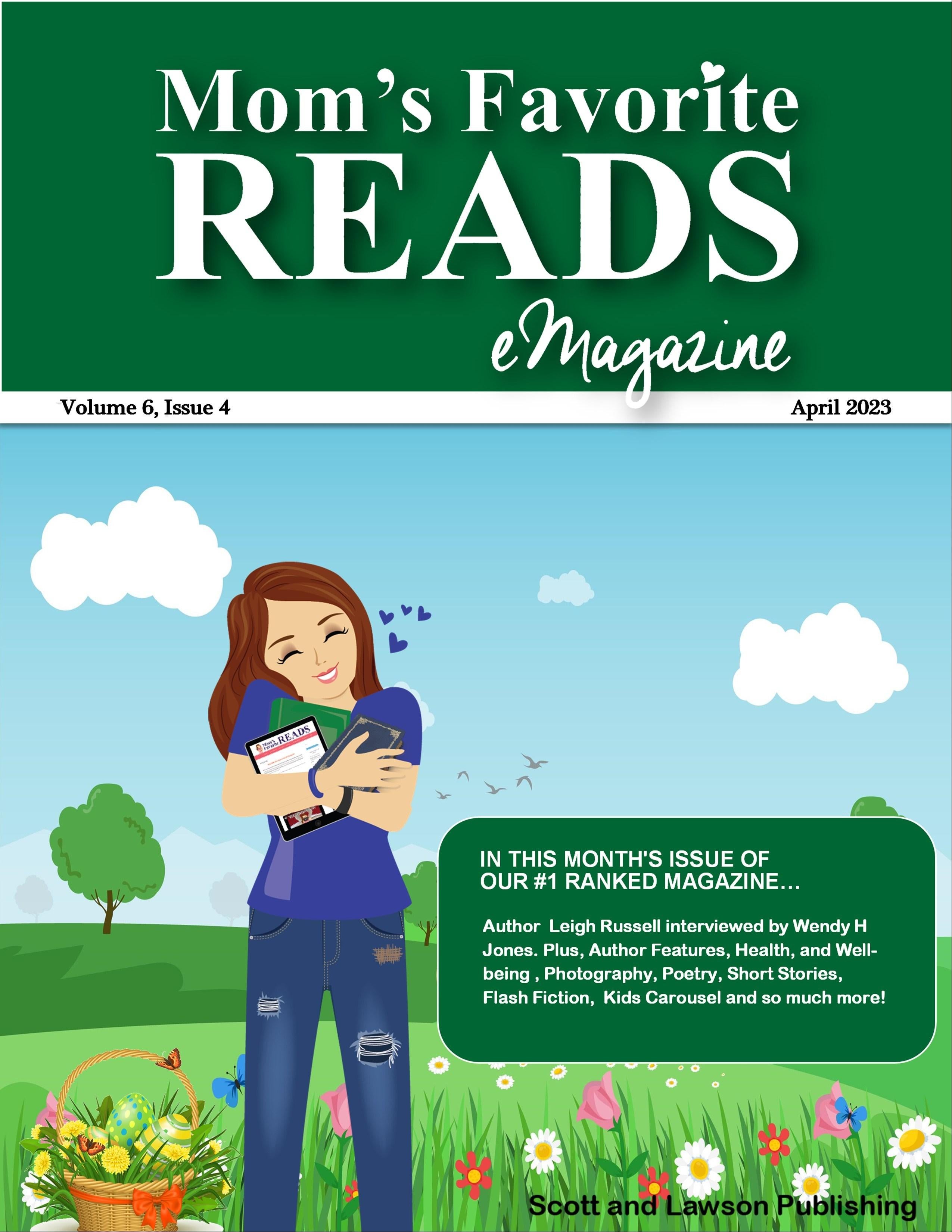




















































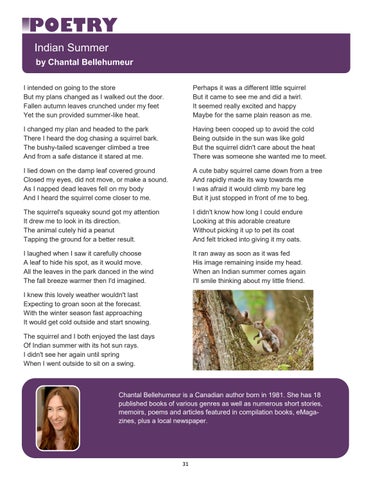



























































Welcome to the April 2023 edition of Mom’s Favorite Reads eMagazine. As this is now my third edition as Editor in Chief, I feel like I am getting into my stride. I hope you enjoyed the first two magazines as much as I, and the team, enjoyed bringing them to you.

This month we celebrate all things Easter, as well as all things diamond. As I have an April birthday my birthstone is diamond, so I couldn’t let the chance for my birthday to be recognised slip past. Happy birthday to all our readers who are also celebrating.
As always, we have a stellar line-up of author interviews, book reviews, short stories, flash fiction, poetry, and articles, as well as something for the kids.
I am hoping I will be able to read the magazine outside, in the sun, with a glass of something cool. Equally, I could be reading it in my sitting room with the heating going full blast and a cup of cocoa. Let’s hear it for good old British April weather.
Wendy H. Jones Author, Publisher, Writing Coach
I am actually writing this while sitting in an Israeli courtyard with the sun shining brightly as I am here on a writing retreat.
Wherever you are reading, I hope you enjoy everything the magazine brings you.


yourself and your books.
My British crime series featuring Detective Inspector Geraldine Steel has sold over 1.5 million books so far in the UK alone. The 19th title in the series, Final Term, was published in January 2023, with the 20th out later this year. This month sees the launch of my brand new cosy crime series, Poppy’s Mystery Tales. In addition to writing, I enjoy supporting emerging writers. As well as running occasional creative writing courses, I am Chair of Judges for the prestigious Crime Writers Association Debut Dagger competition, and carry out educational work for the Royal Literary Fund.

F Scott FitzGerald said, “You don’t write because you want to say something, you write because you have something to say.”
As writers, we don’t look for ideas; our stories find us. I never set out to become an author. On the contrary, I was perfectly happy for half a century as a reader. And then, one day, an idea occurred to me - a moment of inspiration, if you like. I started to write, and haven’t stopped since. I wrote somewhere that it was like turning on a tap.
I was lucky to be picked up straight away by a brilliant publisher, No Exit Press, who have published my crime books ever since my first story. In the fifteen or so years since my debut novel, Cut Short, came out, I have had thirty novels published by three publishers, but I still
continue to write the Geraldine Steel crime series for No Exit Press.

I’m curious as to why you write crime fiction? What is it about crime fiction that appeals to you?


There are a number of reasons for the huge appeal of crime fiction. It is, at heart, goodies and baddies. Killers act on evil impulses, and detectives work to restore moral order and protect the innocent. In a world that appears to be descending into moral chaos, we need crime stories in which, at the end of the story, some kind of moral order is restored. Along with the moral compass crime fiction offers, fictional murder investigations are full of suspense, and offer the reader vicarious excitement.
Crime fiction not only offers writers the opportunity to explore how individuals might react in extreme circumstances, it also allows us to examine how we behave as a society. So in each of my novels I look at a different problem in so-
ciety - homelessness, or gun crime, for example. There are many problems we face as a society. I have no answers to the issues raised in my books, but I think it’s important to raise these questions, and they give crime novels an additional layer of interest.
You write both gritty police procedurals and cosy mysteries. How does this all fit together?
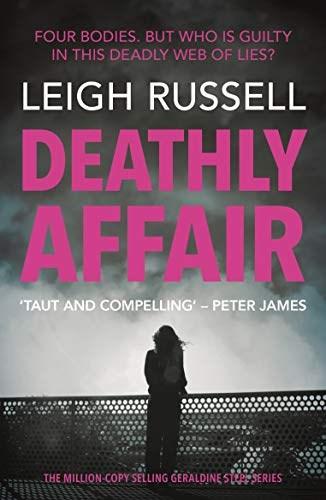
As a reader, I like to consume a wide variety of books, perhaps following a gritty crime thriller with a cosy novel, and constantly dipping in and


out of different genres. The same is true of my writing. During the course of my writing career so far, I’ve experimented with different genres, writing a historical novel, a dystopian novel, and several psychological thrillers, all of which found homes with publishers. So writing a gritty crime series and a cosy series at the same time works well for me.
I’m curious, why the move over to cosy mysteries after so many Geraldine Steel books?
I am still writing about Geraldine Steel. I wrote Barking up the Right Tree more for fun than anything else. Luckily my publisher loved Poppy and offered me a three book deal for The Poppy Mystery Tales. So I’m now writing the two series. The cosy series was never going to signal the end of Geraldine Steel. My publisher has absolutely forbidden me to kill her off!
We always ask authors about their own books but never ask them about their reading habits. What do you read to relax and what books would you pack to go on holiday?
I read widely in all kinds of genres. Over the last couple of weeks, for example, I’ve read two of Lee Child’s Jack Reacher novels, an Alexander McCall Smith’s Mma Ramotswe novel set in Botswana - both crime writers but creating very different books - alongside Margaret Atwood’s The Blind Assassin and Daphne du Maurier’s The Scapegoat, with Ayn Rand’s Fountainhead, and Antony Horowitz’s Forever and A Day thrown into the mix.
The previous month, I read Walter Tevis’s The Man Who Fell to Earth and Mockingbird, Graham Greene’s The End of the Affair, A Sense of an Ending by Julian Barnes, The Golem
and the Djini by Helene Wecker, and The Housekeeper and the Professor by Yoko Ogawa. So my reading is eclectic and completely random.
I’m a sucker for beautiful and powerful prose, and if an author’s writing doesn’t grab me, I may abandon the book and find another one. On holiday, I take my kindle, which has thousands of stories waiting to be read. I will select whatever takes my fancy, depending on my mood at the time.
This is the hardest question to answer for a writer and reader, if you could choose only one book that shaped your journey as a reader, what would it be?
You’re right. This is an impossible question to answer. But if pushed, I would have to say the works of Shakespeare, particularly his great tragedies. I love the power and beauty of language, and no one mastered words better than Shakespeare.
Which author do you think has most influenced your writing?
Honestly? I have no idea. It’s impossible to pick out any particular author.
Do you have a favourite book on Writing and if so, what is it? Again, I know this is a tough one, especially when you have so many friends in the writing world.
I have to admit that I don’t read ‘How to’ books about writing. William Faulkner offered the best advice ever given to aspiring writers, when he said, “Read, read, read. Read everything trash, classics, good and bad, and see how they do it. Just like a carpenter who works as an apprentice and studies the master. Read! You'll absorb it. Then write. If it's good, you'll find out. If it's not, throw it out of the window.”
I have reviewed Final Term and Barking Up the Right Tree in the magazine. Who would these books appeal to?
Final Term would appeal to readers of fairly gritty crime thrillers, readers who enjoy the challenge of working out the identity of the killer, and who are not put off by fictional murders. Barking Up the Right Tree would appeal to readers who prefer their crimes to be a little cosier - and to dog lovers.

And many readers are already enjoying reading about both Geraldine Steel and Poppy.
How do you go about making the switch from police procedural to cosy mystery and then back again?
I can switch from one to the other very easily. When writing a work of fiction, we step into a different world, just as we do when we read fiction. It’s a similar shift into an alternative virtual reality. All it requires is imagination. In many ways, I find it less effort to create another world
myself than to enter one created by someone else.
What are the benefits and pitfalls of writing in two different subgenres of crime fiction?
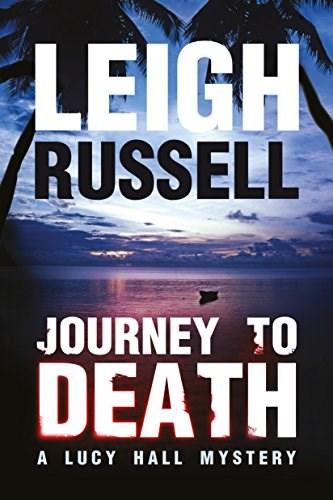
One benefit is the variety this gives me, as a writer. Each subgenre requires slightly different skills, and relies on different narrative voices, and I enjoy dealing with the challenges they pose. I can’t think of any pitfalls. I love writing both series, and am fortunate to have the opportunity to do so.
I’m curious as to how much from your life as a writer spills over to and shapes your fiction?
Very little. I have never killed anyone, I don’t work as a police detective, and I don’t own a
dog. Fiction is a leap of faith for both writer and reader. A writer’s job is to create fictional worlds for readers, worlds peopled by characters invented by the writer. These fictional worlds need to be convincing, but they are not necessarily based on people or events in the real world.
You are a prolific writer with numerous books under your belt. What does a writing day look like for you?
My life ticks along like anyone else’s, keeping me busy with chores and socialising, eating and sleeping. I spend time supporting other writers and read a lot.
In between all the other demands on my time, I spend every available moment writing. And even when I’m not physically writing, a story is always turning over in my mind. As Eugene Ionesco said, “A writer never has a vacation. For a writer, life consists of writing or thinking about writing.”
If you could go anywhere in the world to write, where would it be and why?
My home. My writing career has taken me all over the world - around the UK and Europe, to the United States and The Seychelles, but my favourite place is my home.
Let’s get personal, what would be your perfect meal.
I’m not particularly interested in food, but my perfect meal would be one shared with my family, in a dog friendly restaurant with a children’s menu for my granddaughter.
On holiday do you prefer beach, city, or wilderness? Why?
Probably a city, where there are interesting things to see and do, although I do really love the sea, and was lucky to spend four years by the sea as a student. Other than that, I’ve lived in London all my life, so I’m not really a wilderness girl.
Do you prefer warm weather or cold weather?
Warm. I hate the cold. I’m also not happy with extreme heat. I’m very fussy!
My final question, which one of your books would you recommend Mom’s Favorite Reads readers, read? Now that’s a mouthful and I wouldn't want to try saying it after a glass of wine.
My Geraldine Steel novels are part of a series, but I’m very conscious that I’m writing these books for two readers: fans of the series for whom Geraldine is a familiar friend, and readers who are new to my work. The latter want to be able to pick up any one of the books in my long running series, and enjoy it as much as my existing fans. So I try to ensure my books all work as stand alones, as well as being part of a series. I hope that readers who try any of my Geraldine Steel series will be so engaged, that they will go on to read the whole series.
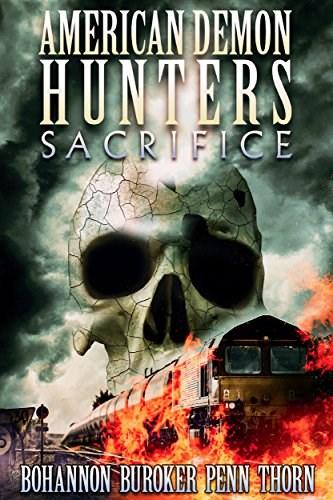
As Barking Up the Right Tree is the first in The Poppy Mystery Tales, I would recommend that to readers of cosy crime. The next two titles in the series, Barking Mad and Poppy Takes the Lead are scheduled to follow soon.
Thank you so much for inviting me to chat with you here. It’s been a real pleasure.
Thank you for taking the time to answer my questions. It is very much appreciated and I am sure my readers enjoyed getting to know you better.
Wendy H. Jones is the award winning, international best-selling author of the DI Shona McKenzie Mysteries, Cass Claymore Investigates Mysteries, Fergus and Flora Mysteries, Bertie the Buffalo children’s books and the Writing Matters books for writers. She is also a writing and marketing coach and the President of the Scottish Association of Writers. You can learn more about Wendy on her website: https://www.wendyhjones.com/


 by Leigh Russell Blurb
Reviewed by Wendy H. Jones
by Leigh Russell Blurb
Reviewed by Wendy H. Jones

When a pupil accuses a teacher of molesting her, his career and marriage are threatened
The girl's corpse is discovered in the woods, and the teacher becomes a suspect in a murder enquiry. The victim's best friend is then murdered so she cannot reveal the killer's identity. The investigating team are satisfied the teacher is guilty, apart from Detective Inspector Geraldine Steel, who believes the wrong man has been arrested.
All of her colleagues disagree... but if she is right, the real killer remains at large.
I love the Geraldine Steel books by Leigh Russell, so was very much looking forward to reading this, the 19th book in the series. I was not disappointed. Before you wonder why I am starting with a book so late in the series, this was the latest one and the publisher very kindly sent it to me. The book is complete in itself and it is not necessary to read the previous 18 to enjoy this one.
It is a police procedural and deals with themes of child abuse, exploitative sex and murder. These are extremely well drawn as are the characters who make this story fairly trot along.
The teenage characters are extremely well written, and Russell has captured them perfectly. The storyline is strong, and the book definitely has that just one more page appeal. I cared about the characters and was rooting for them all, even the more obnoxious teenagers. Geraldine steel is a well-developed character with a strong sense of morality and a dogged determination to catch her killer. I would highly recommend this book to any crime lover.

 by Leigh Russell
Reviewed by Wendy H. Jones
by Leigh Russell
Reviewed by Wendy H. Jones

Cosy mysteries are a new departure for Leigh Russell, so I was delighted to be sent an advance reader copy from the publisher. I like Leigh Russell’s books and I like a cosy mystery; this book was a perfect combination for me.
Blurb
When Emily's boyfriend walks out, she is devastated. As she is puzzling over what to do with the rest of her life, she is surprised to learn that her great aunt has died, leaving Emily her cottage in the picturesque Wiltshire village of Ashton Mead. This inheritance comes with a condition: Emily must take care of her great aunt's pet. Not knowing what to expect, Emily sets off for the village, hoping to make a new life for herself.
In the village, she soon makes friends with Hannah who runs the Sunshine Tea Shoppe, and meets other residents of the village where she decides to settle. All is going well... until her unknown pet arrives. Then Emily's exboyfriend turns up and against the advice of her new friends, she takes him back.
When her next-door neighbour's daughter disappears in mysterious circumstances, Emily decides to investigate, unwittingly putting her own life in danger...


This is a light story, which is a quick read, but ticks all the boxes when it comes to cosy mysteries. It has a sleuth who has nothing to do with the crime fighting community, a best friend to bounce ideas off and a hot boyfriend who functions as both support and a stable influ-
ence. Of course, the ex-boyfriend throws a spanner in the works by appearing back on the scene and causing havoc. One cannot forget the dog, a bundle of mischievous puppy, who helps Emily with the investigation. The tale is well written, draws the reader in and keeps them reading. I did feel, if I were to be hypercritical, that the main character jumped to conclusions a little quickly but, in the end, it all worked out and the book is a good read. I liked all the characters and enjoyed the first in this new series. I am looking forward to reading more.
 by Lis McDermott
by Lis McDermott
The scents of Spring herald growth and new birth,
From the deep, dark soil, buds coaxed by the suns heat, spread forth in their brightest greens adorning the earth.
After Winter’s cold, uninviting season a welcome gift so sweet.
Children spend countless hours decorating bonnets and eggs, excited to eat their weight in chocolate, enjoying family fun.
Around the house they charge, carried by eager legs, on their bunny-trail, happy faces raised towards the warm sun.
Whilst innocents play games to win their chocolate prize, Christians celebrate the day on which their saviour did arise.
All over the world, women in their communities prepare to grace their places of worship with flowers fit for a king,
Gathering garlands of Tulips, Irises, Mary’s Tears and Lilies so fair, praying their efforts will bring joy and happiness as choirs sing.

Lis lives in Royal Wootton Bassett with her husband Conrad, with whom she shares a love of music and films. After a long career in music within education, and as an OFSTED inspector, Lis began to focus on her other passions, photography, and writing. Working as professional headshot photographer and writing coach.
She has since published numerous books on photography, poetry, short stories, and romantic suspense.

Most will think of the Casino, Formula-1, and luxury yachts. Of course, Monaco, where one in three people are millionaires, is a vastly expensive city. But there’s far more to Monaco than money. There are quaint little streets, that you’ll find are in stark contrast to all the glitz and glamour.
We stayed in Castellane, and from there it’s quite a drive to Monaco. But we set off early and spent the day in the city. For the full article, visit my website.
We couldn’t see everything, as we only had one day. There’s apparently an amazing museum that we skipped, although the aquarium is worth a visit and there’s an incredible view over the city from its balcony.
We wandered past the beautiful park, Jardins de Saint-Martin, which is constructed on terraces against the rock and was built to create work in the 1800s. It’s also home to many interesting statues, one being Prince Albert, as well as viewpoints that look out over the sea. Leaving the park near the Cathedral, which is a little hidden, we noticed there is no large square in front of the cathedral, just a narrow alleyway.
There used to be another church, dedicated to St Nicholas of Myra. Yes, that St Nicholas, better known as Santa Claus! The church collapsed in 1874, and after that, this cathedral was built.

Prince Albert, the current monarch of Monaco, lives in The Prince’s Palace of Monaco. The monarchs have lived in this location since the 13th century. Standing in front of the palace, I’m reminded of a Playmobil palace.
Just like the cathedral, the palace doesn’t look too grand on the outside, but I’m glad we managed to see it. Around noon is the Changing of the Guard and in the summer months (Between April and October) you can visit the palace. Inside, you can see a sock and hanky belonging to Napoleon!
This is my favourite part of Monaco. Opposite the palace, there are numerous little streets for you to enjoy. You can eat Mediterranean food and, of course, there are still plenty of souvenir shops. But I do prefer this part over the large, imposing buildings you see in Monaco.


For many people, the Casino is the highlight of their visit. And, true to form, there was a large group of tourists standing in front of the building, gawping at the expensive cars, when we walk past.
Designed by Charles Garnier, it reminds me of the Opera Garnier in Paris. It is possible to visit parts of the Casino.

With a long drive ahead of us, we leave Monaco in late afternoon. As our legs are starting to protest, we take a bus boat across the harbour to our car, parked opposite from the Casino. It gives a lovely view of the yachts and the sea breeze is refreshing. As we leave the motorway near Nice, taking the smaller roads along the river Var, with gorgeous mountains in the background, Monaco seems miles away. We’re glad to have seen the city, but the real attraction of the region is found in Provence’s natural beauty.

Anne Treur is Dutch, living in the east of the Netherlands. She works as PA, but spends her free time travelling, writing, taking photos and blogging about it all! Come and travel along with her, through her website: https://www.ditisanne.nl/annereist-travel-blog/europa/duitsland/romantisch-rijndaldrachenfels-lorelei/ https://www.ditisanne.nl/anne-reist-travel-blog/europa/frankrijk/ monaco-hoogtepunten/

You won’t believe how busy town was this morning. Absolute circus it was. Like Christmas all over again.
I suppose everyone’s scrambling to get ready for Easter now. You can’t move for chocolate eggs at the moment. Has it always been like this? I don’t remember. So much paraphernalia now: chicken costumes and bunny ears for the kids; egg wreaths for your front door; chocolate of all shades, shapes and sizes. Some of those Easter eggs have been in the shops since Christmas. I shouldn’t think they taste too good by now. And hot cross buns? Well, I’m a sucker for those; I won’t lie. But my goodness, have you seen the varieties? Trying to buy a simple bun is a thing of the past. Honestly, I stood there for a good ten minutes or more this morning trying to find a standard pack. They had ones with chocolate chips in them, orange flavoured ones, actual chocolate bun ones; lemon curd and berry flavours, toffee, apple; there’s no end to it. I even saw some savoury ones on the shelf. What’s that all about?

Well, Easter’s only next week. It’ll have come and gone before you know it. Corinne invited me down for the weekend, but I’m not sure I’m up to it. It’s been so cold and my hip doesn’t enjoy that at all.

We had thick snow a couple of weeks ago. I enjoyed watching the kids playing around in it, but to be honest, it just frightens me these days. One slip and I’d be over. Too many people I know have ended up in hospital with a broken hip and never come home. It’s quite sobering when you think about it. They pick up some infection or other. I suppose that’s where all the germs and bugs gather – round the sick people. Perhaps the health service can’t find enough money for good old bleach anymore. I don’t know. I’m probably oversimplifying it, but I stay in when the weather’s like that. I can listen to the radio and do some of the jobs that hang around.
I think these supermarkets need to calm down. Their development team, or whoever they are, would do well to go back to the drawing board and the things we’ve always enjoyed. How hard can it be to make an honest to goodness traditional hot cross bun? Only last week Viv was telling me she can’t find a good Eccles cake for love nor money.
I cleaned the grouting in the bathroom while the snow fell. Nothing like a good scrubbing of dirt to get the blood flowing. Satisfying to see it all clean too. I’m not sure when I’d have got round to that if it hadn’t been for the bad weather. I won’t tell Corinne; she’ll tell me I’m too old to be clambering round the bath with a pint of bleach. Bless her; she does worry.
I always have some tins of soup in the cupboard for those snow days. Child of the war, you see. Mum would hoard when and what she could. Did her own preserving and bottling. They don’t teach that in school, that’s for sure.

It taught me to keep a good store cupboard, so I’m never caught out. Remember how people went mad trying to buy toilet roll when Covid hit us all? It was on the television: fights in the supermarket; women screaming at each other over multipacks, leaving empty shelves for everyone else. I don’t know when we got to be so selfish, hardly the spirit of The Blitz, was it? Just recently it was tomatoes and cucumbers. Honestly, you couldn’t make it up. I mean, back in the day we had to eat whatever the season could give us. Dad grew some veggies in the garden and had an allotment when we moved down off the moors into town. No-one dreamed of eating strawberries or salad in January and February. I think we’re very spoilt now; we expect everything to be available all of the time. It’s unrealistic. We could learn a thing or two from those Ukrainians. I don’t know how they’ve managed to hold on so long. They’ve got some backbone.
I think we’re all looking forward to brighter days now. Last year was long and full of bad news. Now, Spring is on the way and we’ve a coronation to lift the spirits next month too. That should be a spectacle.
I was eleven years old when The Queen was crowned. No TV in our house, but I was invited round to my friend’s house to watch. I think Mum would like to have come as well. A bunch of people crowded round the Radio Rentals shop in the High Street to watch on one of the new sets they had in the window. No-one was at work that day, but eventually Mr Robinson came down from his flat upstairs and let them all in to watch it. Apparently, he was concerned that the press of people might break the glass shop front.

My friend, Barbara, lived across town; her parents both went out to work which was very unusual then. Her mum was a piano teacher and her dad a weather forecaster or something in meteorology. I remember we sat, transfixed. It was all in black and white, but we could imagine the rich colours. It was like something out of a fairytale. We ate iced gems out of a packet – remember those? I’d never seen anything so sophisticated.
There’s something very moving about all that pageantry and history. I’ll be watching it, of course, in colour these days and with a much

sharper picture. I know they’ve changed a lot of the ceremony from 1953. Some of these traditions go back almost 1000 years now, we’ve probably forgotten why we do half of them.
Still, it’ll be a great day out for those brave enough to take on the crowds. I expect London will be heaving with people; all those visitors from round the country and abroad coming to be part of the big day. Too much noise and bustle for me. I’m happier here at home. I think there’re plans for a street party of some sort, so perhaps I’ll venture out for a cup of tea with the neighbours. I think that’s a nice thing to do. I can always rustle up a Victoria sponge for the catering committee.
My friend, Viv, brought me a souvenir mug round last week. That’s what put me in mind of it all, although coronation memorabilia is about the only thing you’ll find in the shops apart from Easter goodies, right now. Bunting, paper plates, inflatable crowns: it’s all there!
My granny had a collection of commemorative mugs which my mum inherited and kept in a glass cabinet. Granny Wilson displayed them in her front parlour, as it was called then. The oldest one was a George IV one which must have belonged to her grandmother, I think. I liked the William IV and Queen Adelaide one. It was a dusky pink colour, I remember, with portraits of him on the front and her on the back; between them there was a garland of roses, thistles, and shamrocks. I thought it was one of the most beautiful things I’d ever seen. Mum scrimped and saved for her royal mugs. Phyllis, my older sister, used to turn her nose up at them. She thought only common people collected them, and she had grand ideas about her own social position. Poor, deluded Phyllis. Shame really
as Mum left them to her specifically in her will. You have to laugh. Goodness knows what happened to them.
Anyway, Viv will be with me on May 6th, watching King Charles III receive his crown. Camilla too. I never thought we’d see that, to be honest. Apparently, it’s what the Queen wanted, so I’ll go along with it for her sake. Not that anyone is going to ask me what I think!

Coronation chicken was invented for our lovely Queen back in 1953. Apparently now they want us to eat lamb with Asian marinade, followed by a strawberry and ginger trifle with twenty-six ingredients. Are they joking? Who has time for that level of fuss? Honestly, doesn’t sound very patriotic to me, but it was all over the paper. I’d rather stick with good old English fish and
chips, a strong cup of tea and a custard cream, but there you are. I suppose we’ll get used to saying ‘King Charles’ eventually, though I think he’ll always be Prince Charles to me. We’ll have to concentrate hard when we sing the National Anthem, so we don’t get the words wrong and let the side down.
They reckon about 26 million people in Britain watched Her Majesty’s funeral last September. I wonder whether the same number will watch in May.

Charles has certainly had to wait a while for his turn. He’s catching up with me at 74. Let’s hope he does some good while he’s there. Viv and I will be watching with interest and raise a glass to his continued good health. You’re welcome to join us if you can squeeze into my house!
Jenny Sanders is a writer, speaker, encourager and mentor. She loves writing, reading and walking in nature whenever she can. For the past several years she’s lived between the beautiful cities of Bath, UK and Cape Town, S Africa. Her exciting and humorous new children’s book The Magnificent Moustache and Other Stories is now available published by The Conrad Press.

I know that the sky is blue, sometimes grey, or as black as night.
I know that the older you get, the faster each day goes by.
I know that luck can change – good or bad.

I know that family and friends are everything, so love them unconditionally.
I know that scrolling the internet can be a waste of time, but I would miss all those cute animal videos. I know that a pedicure is a luxury, but I deserve to treat myself.
I know that when I cook something for someone it’s another way of letting them know that I love them.
I know that it’s a good book when I read it from cover to cover in one sitting.
I know that the best escape is a walk on the beach.
I know that if you want to write about life, go live it.
I know that if anyone mistreats an animal their punishment should be swift and severe.
I know that reading a bedtime story to your grandkids is the best thing you can share with them.
I know the love you give to your pet they give back tenfold.

I know that I should put down those potato chips, but oh they taste so good.
I know that sitting on my porch early in the morning, sipping coffee and listening to the birds inspires me.
I know that it’s important to keep in touch with friends and family.

I know that it’s important to keep your brain challenged and your feet moving.
I know that when you need help, there is no shame in asking.
I know that I love it when my home is clean, but oh how I hate to clean my house.
I know that chocolate is a good thing.
I know that it’s important to keep current on events, but lately the world seems off its axis.

I know that pizza never, ever should have pineapple on it.
I know that the answer to settling differences isn’t violence.
I know that it’s a waste of time to complain. No one wants to hear it.
I know it’s important to say I love you often and mean it. And finally,
I know that when I wake up in the morning with my husband beside me and our little dog Zoey snuggled in between us, it’s going to be a great day.

They say that moving house is the most stressful thing in the life of any dog. But that is nothing compared to losing one’s Anteater in the process.

My humans and I (Sophie here by the way) are now installed in our new home. I was nervous because my humans talked a lot about downsizing. The only other time I had heard that word was when they made the change from sharing their lives with a golden retriever to getting my true Mum Poppy who was a spaniel. I was worried they might be planning to replace me with a dachshund like my cousin Ray. It turned out it just meant taking a dozen car-loads of stuff to charity shops and as many runs to the tip and giving away countless boxes of books.
While they were packing, I had made absolutely certain they would remember to bring my special best friend Anteater, who was my Christmas present from Ray and is also my favourite pillow. I rashly entrusted her to their care, supervising carefully as they placed her in her own conveyance mysteriously labelled “utility dog”. When we arrived I waited excitedly for her to emerge: one day, two days, a week, but no Anteater. I was heartbroken.
I had been so excited because I now have a room of my very own. The nice man who was doing the decorating liked me so much that he insisted he would decorate my room for free! There were some bold orange and yellow paints left over from the previous owner together with sky blue from the master bedroom and seafoam green from the guest bedroom (lucky guests) so I put in a request for a seaside mural. Turned out he didn’t like me that much. My room is kitchen washable blue – some nonsense to do with muddy paws. But it just wasn’t the same without Anteater. Three weeks in and all the boxes in the utility room (the strange name they use for my space) had been opened, but still no sign. Had Anteater gone to charity? Was she among the books on their way to Africa? I could not bear to imagine she had been recycled!
I did not give up hope. My highly trained nose told me my Anteater was somewhere in the house. I had heard that when humans travel on aeroplanes it is normal for them to land in one country while their luggage arrives somewhere completely different. Could Anteater’s box have been delivered to Portugal by mistake? With the doggie persistence all spaniel families know so

well, I persuaded my humans to look one by one among the hundreds of boxes in the study and eventually there she was. She had only been misplaced in transit. Anteater and I are back together again!
Here is the vital lesson for any dogs who are moving house. Do not allow your humans to put your special friends into boxes.

They wouldn’t do that with their precious stuffed teddies. Insist that your companions always travel with you.
Don’t let them out of your sight for an instant. Relocating is traumatic enough without careless humans losing your Anteater.
Married to Ruth, Peter Thomas is a very happy father, grandfather and spaniel owner. He has published three non-fiction books and is delighted to assist Sophie in her creative writing projects. Peter retired in 2023 after 36 years as a Minister of local Baptist Churches - he was originally a teacher of chemistry and computing. He looks forward to spending more time with family and friends, playing piano and guitar, and walking by the sea. He continues to add to his blog of more than a thousand sermons and reflections found at www.pbthomas.com.

 by Tami C. Brown
by Tami C. Brown
Days are longer, birds are chirping, flowers are budding and blooming, children are outside playing their favorite games.

Spring is my reminder that I don’t have to look veryfartosee beautyeveryday.

Tami C. Brown, wife, mother, and grandmother, loves to have her camera ready to snap beauty wherever she goes. Her family and friends, affectionately known as the Queenies, are well prepared for random stops along the journey to have a photo op.



She’s grateful for all photography opportunities and the adventures that come along with it.
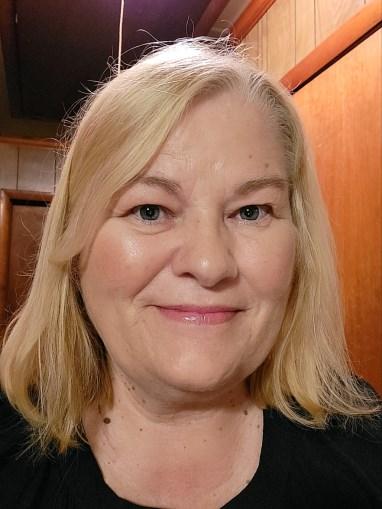
It was his mother I heard of first. ‘There’s a little cat visiting me that looks like a relative of your Miss Matty,’ my friend Izzy said, and messaged me a photo. She was right; the scruffy tortoiseshell skulking on her path had Miss Matty’s face and long, mottled fur, although not the white ruff and paws and general air of being queen of all she surveyed. Given that Miss M’s grand-daughter had gone to Walls, it was likely that this was the next generation. She was visibly pregnant.
‘I’d be interested in a pair of kittens,’ I said rashly, before checking with Philip whether he’d be interested too. Turned out he had grave forebodings, and we had a long discussion on what our big cats would say to an interloper when they all got on so well together, and whether aforesaid potential kitten would be litter-tray literate, given that their grandmother became a byre cat because she refused to use one. I agreed reluctantly that it was a bad idea, and I stuck to that through Izzy’s other visiting girl having three kittens in her airing cupboard.

joyed a good chase round the house, which a kitten could join, and Miss Matty could teach him ball skills and curtain climbing.
Then Izzy phoned one evening. She’d managed to trap the mother and have her spayed, and had now caught the kitten, who was living in a cage in her kitchen. ‘He’s such an affectionate wee boy, but my ginger Freddy hates him, so he has to stay in the cage, and I’m off south for a week.’
I tried the photo on Philip: a wide-eyed kitten with paws he’d grow into and a strong look of his great-great-grandfather, our beautiful Petrov, who was killed on the road. He wasn’t Petrov’s lovely ash-grey, but he was prettily striped, with pale fluffy lugs. ‘We could try him,’ I coaxed. ‘Probation for a fortnight, and see how they all get on. Izzy has another possible home if our lot are just too mean to him. We could go and meet him, at least.’
Of course, we brought him home with us that evening. He had to stay in the cage overnight, and he was still nervous – he’d been feral until a week ago – but he let himself be picked up and purred at being stroked.
I wasn’t totally convinced though. I thought a lively kitten would do us all good. Magnus, our substantial stripey boy, might enjoy a young apprentice to stalk round the garden with, especially if aforesaid apprentice did the actual work of chasing off strange cats while Magnus sat imposingly on the peat stack. Our girls, Miss Matty and her daughter, Génie, both en-
The big cats were wary, but not actively hostile. It was still summer, which they all spend mostly outside anyway, so they came in for their breakfast while he was eating his, then headed out again, giving the living room a wide berth. There was only one odd reaction. Our older cats aren’t great hunters, but the occasional bird or mouse is not unknown, so when I got up to the toilet in Kitten Brendan’s first night, I was sorry but not surprised to see a corpse on the floor. Skylark, I noted, as I put it in the bin. Philip found a second one and a live bird when he went to make the tea, and I found a fourth, dead, when I opened the front door. None of them had been played with (normally you can’t quite tell what species it was without looking closer than you want to), so they weren’t, as Philip suggested, taking out their wrath at the arrival of a kitten on the local wildlife. Either they were contributing to his upkeep or making

it clear that we didn’t need a young male cat to stock up the household larder.
Male he most definitely was. I remembered that walk very well; he swaggered across the room in just the way Kitten Petrov had done, like a teenage motor-biker in too-tight jeans, and wolfed his food in just the same way. Those of you who have multiple cats know how the pecking order goes: like lions, the oldest male is nominally in charge, although the oldest female actually does the work. As an unsorted male, Kitten Brendan assumed he was headed for top cat.
On his third day I had the oddest moment of telepathy. I’d sat down on the couch and he’d come to sit on my knee, looking up at me. As I was stroking him, suddenly I felt him remembering that someone used to wash his face and ears, and he’d curled up against her, and it was warm and safe, and how lost and frightened he’d been in that week since. He was only a little kitten, after all. I gave the inside of his ears a rub with my thumb, and he relaxed completely as if he knew that he was safe again, and purred like a kettle about to boil, then fell fast asleep.

After that I was adopted as mum, and his confidence soared. When we came down in the morning he came bouncing out from inside Philip’s piano; he explored the conservatory and made his way upstairs, and, since it was summer, he went outside and met the big cats. I hesitated over letting him out. If he’d had a normal kitten upbringing, of course, I wouldn’t have dreamed of letting an eleven-week-old baby into the wild world. However, as a feral kitten he had skills I thought he should keep, and so, one sunny morning I propped the door open and let him venture into the front hall. By now the big cats had got used to him. Kitten, ate from their bowls (everyone was on kitten food), used their litter tray in preference to his own, small, bouncy, mostly harmless. Miss Matty and Génie had gone out into the garden, and Magnus was on the doorstep, considering the day. Kitten Brendan went cautiously up to him, sniffed whiskers and dodged past, then sat on the lower step in exactly the same pose.
‘Me and Magnus,’ I could just hear him saying.
‘We’re on watch. You girls don’t need to worry. Me and Magnus have it all under control.’ When Magnus strolled off into the bushes,
Brendan charged excitedly after him. There was a bit of a scuffle, and a squeak, which had Miss Matty going to look. It had sounded more like Magnus, but surely he wasn’t scared of a kitten a quarter of his size. I called, and Brendan came back and played on the doorstep for a bit, then came in when I did.
Things seemed to be going well. He was a really sociable little fellow, keeping us company wherever we went. Once he’d mastered paw control, he dribbled balls round the house, and lost them under furniture. He learned his name, and that he could sit on my lap or shoulder during meals, but the first nose or paw on the table had him back on the floor. When we left the door propped open, he made forays outside, but returned when I called him. He even played around my feet while I practiced the flute, which was more enthusiasm than any of the others had shown. The only place he didn’t go, to my surprise, was into my writing room, where Magnus slept in the airing cupboard; maybe he was respecting the Ruling Male’s domain.
As for the big cats, well, they started coming back into the house, pausing to watch him as they went from hall to conservatory. Génie seemed the least worried, sniffing his whiskers as he passed; except that when I was lying down one day, with her on my chest, Kitten Brendan jumped up on the bed too, and tried to ingratiate himself. He really did try; he lay on his back, exposing his round spotty tummy, and wriggled up to her, purring his loudest. I willed her to give his imploring wee face a lick, but when he tried to pat her with one paw, she gave him a hiss and bop on the nose instead. If she’d wanted to adopt a child in middle age, I felt her thinking, she and Miss Matty would have organized it themselves. It was unfair of me to dump one on them and expect them to mother it.
All the same, my hopes kept rising. When he came up while Miss Matty was communing with her mistress, he kept a respectful distance down the bed, and she made it quite clear that she didn’t see a kitten anywhere, and went to sleep. In which case, he obviously reasoned (he was the sort of kitten who’d have got a posthumous VC in the war), he could sneak up to under my chin. He might have got away with it if he hadn’t tried to walk over her.

Kitten / cat relations went downhill after that. I think he decided then that he liked us, he liked the house, he loved the garden, with all those exciting bushes to chase into, and he wanted to keep them. The other cats had to go; and he started with Miss Matty, either because she was the smallest or because he’d sussed her out as the real Top Cat.
I tried to think it was admiration at first. When she jumped up onto the windowsill, he followed. When she curled up on the couch, he curled up on the floor below, ready to follow her when she woke again. Philip, being male himself, found it more sinister, and when I stood one evening and watched Kitten Brendan chase first Miss Matty and then Génie from their own front door into the bushes, I had to agree. Even Magnus had taken to walking around him. He was cruisin’ for a bruisin’, but if it came to a fight, I wasn’t sure Miss Matty
would win. He was nearly as big as she was, and the rate he was growing, even if she sorted him out now, it wouldn’t be long before he got his revenge. Alternatively, she might run and leap over the wall, and he’d follow her onto the road. I thought of our Petrov and couldn’t bear another road casualty.
With a heavy heart I picked the cutest photo of him and made a notice for the shop: Wanted, only-cat home for lovely peerie ketling. I explained that he was house-trained, very affectionate, but already bullying our big cats. The first folk to see the notice took it down again, and came round to get him: just the home I’d have wanted, down by the marina, with an older stay-mostly home couple. The wife even played the flute.
It took a full week and a half before the other cats were back to normal. Magnus finally emerged from the airing cupboard and took over the conservatory chaise longue once more. Miss Matty returned to my desk to supervise my writing. Génie at last came to demand her Dreamies at 20.30 prompt. ‘No more kittens,’ I promised them.
All the same, his new house is only diagonally across the football pitch, and we do have the most interesting garden in the village, from a cat point of view. A man needs to patrol his extended territory.

Marsali Taylor grew up in Edinburgh, and studied English at Dundee University before teacher training college. She moved to the Shetland Isles for her first teaching post, and loved it so much that she’s stayed there ever since. She’s now the author of ten Shetland-set detective stories starring liveaboard sleuth Cass Lynch and her partner DI Gavin Macrae. She’s also published a history of women’s fight for the vote and articles for a local magazine Shetland Life. She has a monthly column in Practical Boat Owner. Apart from writing, she spends her summer messing around on the water in her 8m yacht Karima S, and her winters involved in the village pantomime

I intended on going to the store
But my plans changed as I walked out the door. Fallen autumn leaves crunched under my feet Yet the sun provided summer-like heat.
I changed my plan and headed to the park There I heard the dog chasing a squirrel bark. The bushy-tailed scavenger climbed a tree And from a safe distance it stared at me.
I lied down on the damp leaf covered ground Closed my eyes, did not move, or make a sound. As I napped dead leaves fell on my body And I heard the squirrel come closer to me.
The squirrel's squeaky sound got my attention It drew me to look in its direction. The animal cutely hid a peanut Tapping the ground for a better result.
I laughed when I saw it carefully choose A leaf to hide his spot, as it would move. All the leaves in the park danced in the wind The fall breeze warmer then I'd imagined.
I knew this lovely weather wouldn't last Expecting to groan soon at the forecast. With the winter season fast approaching It would get cold outside and start snowing.
The squirrel and I both enjoyed the last days Of Indian summer with its hot sun rays. I didn't see her again until spring When I went outside to sit on a swing.
Perhaps it was a different little squirrel But it came to see me and did a twirl. It seemed really excited and happy Maybe for the same plain reason as me.

Having been cooped up to avoid the cold Being outside in the sun was like gold But the squirrel didn't care about the heat There was someone she wanted me to meet.
A cute baby squirrel came down from a tree And rapidly made its way towards me I was afraid it would climb my bare leg But it just stopped in front of me to beg.
I didn't know how long I could endure Looking at this adorable creature Without picking it up to pet its coat And felt tricked into giving it my oats.
It ran away as soon as it was fed His image remaining inside my head. When an Indian summer comes again I'll smile thinking about my little friend.
Chantal Bellehumeur is a Canadian author born in 1981. She has 18 published books of various genres as well as numerous short stories, memoirs, poems and articles featured in compilation books, eMagazines, plus a local newspaper.



In Scotland, we are about to step, rather eagerly, into spring. It is a time of rejuvenation, internal growth, and positive energy as our surroundings are brought back to life after the winter months. The dreary browns slowly dissipate, replaced with fresh greens and pastel colours, as spring lifts our spirits and propels us towards summer.
And, speaking of being brought to life. As a children's author, I am vehemently aware that no matter what I write, the front cover will initially draw attention to my books. The blurb will then battle with the internal illustrations for the second billing.
Illustrators play a crucial role in the production of picture books. They bring our stories to life. Giving our characters quirks and characteristics that feed our stories and transform our written words into visual worlds children will adore.

To tell us a little about life as an illustrator, please welcome Helen Morrish to the Kids Carousel.
Helen, please tell us a little about yourself and your writing/illustrating career.
After studying Fashion Illustration, I got a job as a designer for a magazine, I absolutely loved it, designing and illustrating all day! My dream was to have my own magazine, so in my spare time a friend and I edited a fanzine. We photocopied it on an old xerox machine, gave it to friends, and out at festivals and nightclubs. This was the 1990s so, in a way, it was my first venture into selfpublishing!
I worked my way up to Art Director for a big selling Women’s magazine, it was a fantastic job, but as you get higher up the ladder your responsi-
bilities change, and it started to get a bit uncreative So, after thirty years working for various publishing houses, I decided to leave and pursue my dream of being an artist, spend more time with my husband and generally have a slower pace of life away from London working.
Then unexpectedly, my husband sadly passed away and I was thrown into that awful cycle of grief where you can’t concentrate on anything. My creativity was at an all-time low, and I desperately needed to get it back. The only thing I could concentrate on however, was the mundane scrolling on Instagram and this had its uses and I came across an art challenge- to draw the everyday, every day, and decided to give it a go. I started slowly drawing things around my house including my dog, Rupert. I added little speech bubbles to his pictures and began to wonder how he, as a dog might be processing the loss of his beloved owner. And so, Rupert’s book was born.
Where does your inspiration come from?
It comes from a variety of sources, I’ll go to an exhibition, and something will spark an idea, or I’ll see a film and love the colours in a particular scene, or I’ll hear a conversation or anecdote and turn that into an idea for an illustration. My house is a huge inspiration too, I collect all things retro and kitsch, and most of it appears in my work.
Do you have a preferred technique or medium?
My favourite pen is a Sharpie and I always carry an A6 sketch book with me. I’ll then redraw my sketches using a light box to trace over them until I’m happy and then scan them into Photoshop, it’s brilliant for adding more detail or manipulating an image. If I want a change of
perspective, I can do this without redrawing the whole image. If I can’t draw from life, then I’ll do some picture research and hand draw from that. I have two styles: a graphic style where Photoshop plays a big part, and a lighter hand drawn style using pencil and watercolour. Is there a favourite illustration/piece in your portfolio?
For my final Art College project, I did my own version of Time Out Magazine. I used illustration, photography and writing to re-create the amazing characters that lived and worked along the Portobello Road. I found it recently in the loft and posted it on Instagram, I was then asked to illustrate a map for our local area. It’s wonderful to think that a thirty-year-old project could lead to a commission now, I’m also using it as inspiration for a future book.
Where can readers find out more about you?
Website helenmorrish.co.uk
Instagram and TikTok @helenmbooks
For behind-the-scenes Instagram @ladycrimplene
So, in keeping with the theme of internal growth, the Kids Carousel is reviewing a newly released picture book that combines stunning illustrations with a powerful message about facing our fears.
Published By Nancy Paulson Books, February 2023
For ages 3 to 7 years
Today is Hannah’s violin recital, and the day she has been dreading.
From the music she creates to the way it makes her feel, Hannah loves playing her violin. But the thought of playing in front of an audience terrifies her.
She spends the day wishing something wild would happen. Imaging a raging storm, rabbits burrowing into her kitchen, or dolphins spilling from a waterfall, all so she would miss her recital.
But nothing wild happens. At least, not until she steps onto the stage with wobbly legs and nervous jitters. Hannah begins to play her violin and, as she does so, she realises that her hands remember what to do. Her love for playing her violin takes hold and she performs beautifully. Hannah soon discovers that her performance is a wild and enrapturing experience.
While Something Wild is simply written, it undoubtedly sends a powerful message in encouraging children who may become anxious in certain situations. It is about supporting and nurturing children as they face and overcome their fears. And when I say that it is simply written, I mean that as a compliment. It gets straight to the point. Allowing the message to be delivered quickly if a child is anxious.

Stunning illustrations accompany this simple story, bringing Hannah’s imagination to life in a whirlwind of colour.
Pauline Tait is a prolific novelist and children’s author. Based in Perthshire, Scotland, she writes both suspenseful romance and children’s picture books for 3 to 7 years. With a background in Primary Literacy Support, Pauline is passionate in encouraging children in their own reading and writing.
Visit Pauline’s website – https://paulinetait.com


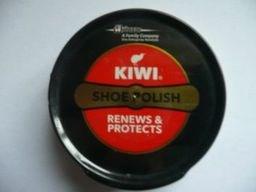 by John Greeves
by John Greeves
So where have all these once familiar products and brands gone? You probably have your own childhood list of bygone favourites including penny sweets like: sweet banana, chocolate mice, pink shrimps and chewy black jacks. Even the chopper bike, Subbuteo table football and the Pogo ball, that once promised to ‘jump you out of the 50s into the 80s,’ have all sadly had their day. If this isn’t your era, then think about the rapid pace of obsolescence in the last decade or so. Gone are incandescent light bulbs, Kodak film, TV consoles, floppy discs, rotary telephones, fax machines, Internet Explorer, yellow pages directories, internal CD and DVD drives with a new computer...even the printed editions of the Encyclopaedia Britannica, have vanished, shrouded in an ephemeral mist of yesterday’s news. You just have to check out the declining high street, to see wellknown brands and products, we thought would last for ever, now declared extinct.
Now I learn ‘Kiwi Shoe Polish’ is the next to leave our sceptred isle. It seems, Britons are not polishing their shoes and boots frequently enough and the market leader has decided it’s not worth selling Kiwi shoe polish in the UK any more. A spokesperson for SC Johnson explained why Kiwi Shoe Polish had decided to leave Britain. “The Shoe Polish category has shown a steady and long-term decline. There are several reasons for this change in demand, including a rise in wearing of casual shoes, which do not require formal polishing, and an overall decrease in consumers polishing their shoes. SC Johnson continues to maintain an active presence for the iconic Kiwi® brand in markets where formal shoe care remains relevant.”

Sad to think that the act of polishing your shoes, once had the same cachet as learning to swim, riding a bicycle or telling the time when you were younger. Polishing your shoes became a
regular ritual every Sunday night in readiness for school the next day. There was a set protocol. First the laying down of a broad sheet newspaper, then the assemblage of various hard and soft bristle brushes, a rite of passage with an undisputed order: shoes must be clean and dry before starting; polish was to be applied with a clothe or a hard bristle small brush and allowed to dry. Only then could buffing begin with a larger soft bristle brush in rapid movement until a mirror glean appeared. You weren’t finished yet, before another light coat of polish was applied and the shoes sprinkled with water, before buffing them up again to a military shine.
Kiwi shoe polish seems to have been with us, our parents and grandparents all their lives. Its origins began in 1906, when a Scottish ex-pat called William Ramsay (eldest son of John Ramsay), launched his shoe polish in Australia. William had arrived in Melbourne, with his parents and his brothers John and Hugh. The family soon expanded with three sisters and two more brothers born in Melbourne. William initially joined his father in John Ramsay & Son, a prosperous real estate business until he ventured out on his own. In New Zealand he met and married his wife Annie Elizabeth Meek in 1901, before he returned to Melbourne to establish his own enterprise where he formed a partnership with Hamilton McKellan, manufacturing a range of products including disinfectant powder, stove polish and boot cream. The first KIWI
factory was at 62 Bouverie Street in Carlton, Melbourne, Australia.
‘Kiwi’ polish came later and was named after his New Zealand wife. The polish was not the first boot polish on the market, but what made it different was its formula to preserve and restore the colour of leather and make it water resistant. By the end of the first year William had sold 86 gross and within ten years KIWI had sold 30 million tins of polish. The range increased and included: Dark Tan, Light Tan, Brown, Ox Blood, Black and a patent leather polish.

After the war sales of the Kiwi shoe polish continued to grow with distribution in fifty countries. Times change, and the company survived the Big Crash of 1929, the second World War and later the process of modernisation. During the second World War, one American correspondent, Walter Graeber even described the Tobruk trenches in 1942, where “Old tins of Britishmade Kiwi polish lay side by side with empty bottles of Chianti,” an affirmation that Kiwi Shoe Polish had become a global product. Indeed, the breaching of the American market occurred a few years after the war when a new factory was opened in Philadelphia.
Modernisation, expansion, new machinery, quality control and new products became the buzz words for the company during the fifties and further new plants opened in Britain, India, France, Canada, South Africa, Spain and Pakistan. By 1967, the company had grown so big that all its diverse interest needed to be brought under an umbrella company so Kiwi International, was born. Other changes occurred, and in 1982, a merger took place between two well established Australian companies, Nicholas International Ltd and the Kiwi Polish Company Proprietary Ltd that now formed Nicolas Kiwi.
Sales rose dramatically with a growing acceptance for this product which offered quality and performance, along with a wider application for saddles and other leather goods.

By 1908, Ramsay began to export to New Zealand and Europe. In 1912, the Ramsay family established a sales office in Southampton, England with a staff of three. Leather shoes and boots were becoming more available to the public, so the demand for a quality and dependable polish increased. Unfortunately, William died aged 47 in 1914, never realising the true global impact of the product would make in the future. The company would remain a family run business for several decades.
During the first world war, the polish became increasingly popular with soldiers in the British and US armies. Trench warfare had brought with it a dreadful condition called ‘trench foot.’ One way to avoid this was by having dry feet and ensuring your boots were Kiwi water resistant. A single order from the British Army totalled 10,000 gross. (Roughly 1.44 million tins).
Dealings didn’t stop there and in 1984, Kiwi was bought by Sara Lee Corporation, before being sold in 2011 to SC Johnson, the present owners who now want to focus their activities on other priorities. Kiwi Polish will no longer be sold in the UK, the firm will instead sell products in countries where formal shoe care “remains relevant.” It is still bought in more than 120 countries and accounts for more than half of the shoe polish sold globally.
Kiwi shoe polish has been a part of Romi Topi’s and his family life. He’s sad the shoe polish, so familiar to various generations of his family has finally gone from Britain, but like all good businesses he acknowledges change.


Romi Topi, runs Top Shine Shoe Shine services which has provided a services for the last 22 years. He was taught to polish shoes by his father. The services are based in two prestigious locations in London’s Burlington Arcade and The Royal Exchange. Romi tells me “When we talk about shoe polish we automatically think ‘Kiwi Shoe Polish’. It was always there on the shoe cabinet and it’s been part of our lives.” Romi puts the falling sale of Kiwi polish down to a number of factors including the increase of British shoe makers selling shoe care products, the change of life style that has occurred during Covid and compares the City more to a university campus, than a formal working environment. He and his colleges have had to adapt their services to new footwear

trends in addition to polishing leather shoes to catering for the rise in casual wear. Some people are paying £3,000 for Nikes, so it makes sense to know how to clean trainers. His service not only polishes shoes (£8), cleans Suede (£12) but now offers a trainer service (£15) as well as selling a range of his own “Top Shine” shoe products.
Of course, change has to happen, but perhaps what is most disconcerting is the rate at which quality brands and products are disappearing from our shores. You have to wonder what’s next when it comes to the future culling of much loved products. Formality it seems has been cast aside, with the once famous city gent, formerly ‘suited and booted.’ He’s now replaced by a casually dressed office worker with shoulder bag and of course those ubiquitous trainers (who wouldn’t be out of place at Glastonbury) and whose only interface these days, appears to be with an office computer.
John Greeves originally hails from Lincolnshire. He believes in the power of poetry and writing to change people’s lives and the need for language to move and connect people to the modern world. Since retiring from Cardiff University, Greeves works as a freelance journalist who's interested in an eclectic range of topics .
April seems such a sweet, Spring-like month, although it’s quite capable of giving snow as well. To me, the April just before we adopted our children, was a stormy one, that passed in a blur. We had been running a language school from our house for a few years, so whilst getting ready to bring three young children home, our house was filled with teenagers most weeks.
Having had to go through a stack of paperwork in the previous year, it seemed surreal that we had suddenly come to the end of the journey, and were actually going to be parents. Nearer the end of the month, we started using host families for the teenagers, allowing us to finalise the rooms, adding the little beds and soft toys that featured in the DVD we made for them.

Walking around Ikea, we wondered how many things we could get into our car. It was tempting to buy every toy we could afford, but we stuck to cute kids' plates and cutlery. Maybe the odd extra. Or maybe a few odd extras. Those kids' curtains were very cute and we simply needed spare bedding, right?
We prepared the house and garden, installed stair gates, set up a cot, and filmed ourselves going around the house, showing our childrento-be where they would live. It might have felt awkward and cheesy, but it did serve its purpose. For the two younger ones, we made talking picture books, all the while teaching teenagers to speak English and playing language games around the area.
In April of that year, we met the foster carers looking after our children, which felt odd. We talked to them, and after the meeting, they went home, to what would become our children. After each meeting, we travelled home again, to cook ginormous meals for hungry sixteen-year-olds. After the meal, when the teens had gone to bed, we would look at pictures of our three little ones.
The months passed so quickly, although it didn’t feel like it at the time. Soon, we were on our way to the sweet cottage social services had rented for us, and we would meet our children for the very first time. I had been teaching most of the day, and my adrenalin made me feel shaky for most of the long journey. How surreal, to meet your children, who you have only seen in pictures, but we had such strong feelings for them already.
So, each April, I feel the chaos won’t be as wild as that one April, ten years ago.

Maressa Mortimer is Dutch but lives in the beautiful Cotswolds, England with her husband and four (adopted) children. Maressa is a homeschool mum as well as a pastor’s wife, so her writing has to be done in the evening when peace and quiet descend on the house once more. All of Maressa’s books are available from her website, www.vicarioushome.com, Amazon or local bookshops.

 by Michael L. Ross
Reviewed by Lisa Turley
by Michael L. Ross
Reviewed by Lisa Turley

Set during the end of the Civil War where racial divides were strong, this split time story of Will, Luther, their families and the building of railroads is not only intriguing, but very emotional!
Will has lost so much already, but when the opportunity comes along to be part of founding a new town, he has to take it! The question is, will he (they) be able to bring it to fruition.
Luther, a black man from Kentucky, forges his way to Indiana only to find that the Black Codes will still not allow him the freedom he’s looking for.
Will these two men be able to make a new beginning or will the railroad pass them by and make life even more unbearable for them and their families?
I love how the author made the characters warm and inviting to get to know which made a larger book a joy to read. His gift of weaving the perfect amount of detail to keep you wanting to turn the page is fascinating.
Though this is the third book of the series, I found it easy to read as a standalone without losing the history of the first two books of the series.
As much as I loved the book itself, I was equally enthralled with the history given in the author’s notes section of the book. That was the icing on the cake so to speak and showed just how much effort and research went into this amazing work of true to life fiction.
Fun Facts:
The settlement of Nicodemus was part of a greater movement of westward migration that occurred in the latter half of the 19th century. Several technological and cultural factors contributed to the growing trend of movement, enabling and encouraging new groups to move west.
Lisa Turley is from West Virginia. She is on numerous ARC street teams and reads in multiple genres. She is passionate about helping authors get the word out about their books.
Since the arrival of the Santa Fe Railroad, Lubbock has grown to be one of the country’s leading inland cotton markets and the center of a highly diversified agriculturalindustrial complex.


Petroleum, agricultural, and earth-moving equipment, cottonseed oil, and engineering products are major commodities.
Lisa Turley is an avid reader from West Virginia where she lives with her husband and three für babies. She is on numerous ARC street teams and reads in multiple genres, her favorites being historical and Christian Fiction and suspense. As a small business owner she knows the importance of promotion and is passionate about helping authors get the word out about their books.

 by Eileen Rolland
by Eileen Rolland
We start with Wood for a reason. It is the beginning of things. Its season is Spring. It is the time of year when things begin to grow, when new life emerges after winter. It is about birth and infancy in terms of stages of life but it is also about the ‘birth’ of anything new: a new job; hobby; project; relationship and any work one undertakes whether it’s knitting a sweater, baking a cake or writing a novel. The fact that the work has been started is Wood energy in action.
Wood is considered the ‘child’ of Water. It is about taking the formless creative energy of Water, giving it substance and bringing it into being, effectively changing energy into matter. Although the term ‘wood’ represents all vegetation, it is symbolised by a tree. Being rooted in the earth (yin) but with its branches reaching toward heaven (yang), it creates a link with both energies to give them form.
Wood organs are Liver (yin)
and Gallbladder (yang). When we talk of Wood energy, both these organs are taken into account. The liver is the largest organ in the body. It generates bile which drains into the gallbladder and is stored there until needed for digestive processes. It metabolises carbohydrates, proteins and fats. It regulates blood sugar, synthesises blood-clotting agents, produces red blood cells and detoxifies the body.
In Eastern medicine, Liver is about flexibility, about taking things in our stride and adapting to change. It nourishes our self-esteem, controls the sinews and manifests in the nails. Liver opens to the eyes. Someone who has jaundice will have a yellow tinge to their skin as well as the whites of their eyes. Liver is about vision and direction and is even said to promote inner vision. It helps us to see our way forward while the Gallbladder is associated with decision making.
Liver governs the ‘fight or flight’ response. Wood is active when we decide what course of action to take in a given situation. Liver can be diminished by high levels of stress. In Chinese Medi-


mes, sour plums, yogurt, pickles and sauerkraut are examples of Wood foods. Wood is also associated with foods that are not quite ripe or sprouting foods such as bean sprouts. Also, foods that grow upwards on strong stems have a Wood connection; asparagus, wheat, corn and celery, for example. All green vegetables have an affinity with the Wood element and can be used to tonify the Liver and
of Fire, and FIRE energy will be next in this series. As Fire is asll talk about it in

taught classes in both disciplines since 2004. Now that she is retired,

washing, prepared for you, called Ivy. Use the one with the large leaves. Lots of people will s easy to find. All you need is a pair of scissors and cut about nine or ten leaves, without stems. You might want to wear gloves if you find the plant is an irritant to your skin.


Cut nine or ten leaves off, using fresh leaves for each wash.
Rip the leaves into small pieces, using the natural lines made by the leaves.
As most of my children have left home, I don’t use the washing machine as much. When they were all teens, there was so much washing each time! If only I had known then that there was this great way to save money on detergent... And it was growing, right in front of me! We had a low hedge between us and the neighbours, covered in ivy. Now, it takes me a two-minute bike ride to get some, which is not bad.
By sharing this on my blog, I hope others can benefit. For the full article as well as other materials about home and living, go to my blog.

Last week, I saw this heading: Free detergent for coloured washing. I was sure it would be some hippy tip that doesn’t actually work, it just sounds nice and green. In this case, it was a great idea! Free detergent for coloured
Put all the pieces in a thin sock or little washing bag. Don’t forget to tie the sock...
The sock or bag goes in the washing machine
Wash normally, then take the sock/bag out and put the used leaves into the food bin/ compost
There are a lot of things working together in Ivy, as I explained in the full blog. It also makes the plant mildly poisonous, so don’t eat ivy.

I tried it myself, together with my sister-in-law. I wasn’t sure at first, and as I was worried my washing would smell of ivy, I added a few drops of washing perfume to mine. My sister-in-law said hers smelled fine, a little bit like nature...
This morning, I did a wash using just the leaves, and she was right, the smell is fine! It smells outdoorsy and clean. Of course, you could add something to it if you want, but it does make your washing clean, for free! So there you are, another way for you to save money this Spring!
Gerdie van Wingerden is a Dutch blogger and mother of four children. She loves to share her passion for homemaking and interior design. Gerdie works in a Home and Giftshop as a stylist, as well offering her services as advisor on her website, No34.nl, where her blogs are regularly posted as well. www.NO34.nl.

 by Val Tobin
by Val Tobin
At age 14, his now late parents hired his first private astrology tutor, with whom he studied for two years. At age 16, he started doing free readings for anyone who was interested. He did free readings until age 18, when, on March 18, 1974, he officially opened his professional astrology practice. In 1980 he earned his Diploma from The Faculty of Astrological Studies, located in Oxford, UK.
I first connected with Zayin on Facebook I don’t even remember how or when but his astrology-related posts got me curious about his background and knowledge of the subject.
I sent him some interview questions, and he agreed to answer them for Mom’s Favorite Reads readers. The result is an interesting discourse on western astrology. Responses are edited for clarity.
VT: How did western astrology evolve? I thought it originated with Vedic astrology.
ZC: “Western Astrology is the oldest form of Astrology. It started around 3,000 B.C.E. as Babylonian astrology, with Hebrews under Babylonian control.
“The Hebrews were the first people to apply astrology to personal human everyday events and personality traits. Before then astrology was applied to only Kings and world events. Vedic did not exist until around 1,200 B.C.E. as Hinduism was then highly evolving. From the beginning Vedic astrology applied to both world and everyday personal events. To this day it’s the most predictive form of astrology, except for Horary Astrology.
“
Horary astrology is the branch of astrology that deals with answering a question by studying the astrological charts set for the exact time and place of asking a question. It’s the most ancient branch of predictive astrology. The astrologer answers a question by constructing a horoscope for the exact time at which the astrologer received and understood the question.”
VT: Does astrology imply everything is preordained? How much is within our control?
ZC: “No. Astrology is simply a guide to the probable outcomes of events, and the outcome can be changed with foreknowledge. We all have free will. The amount of control varies based on one’s knowledge and the type of aspect that is involved. For example, Transits are 50% internal and 50% external. Progressions are mostly always internal events, while Solar Arc Directions are mostly always external.”
VT: What can someone with a dismal chart do to affect the outcome?
ZC: “One cannot change their birth chart; however, one can use the highest level of even a negative aspect in their chart. For example, someone with, say, negative Neptune accepts, which can manifest as drug addiction or as a high spiritual path, has free will. With knowledge, he or she can avoid drug and other addictions and instead study meditation, spirituality, and other positive sides of Neptune.”
VT: What are the benefits of having an astrology chart done?
ZC: “Gaining knowledge of the true self and one’s true paths, which the chart provides. To truly know oneself and view the probable outcomes in life. An astrology chart arms a person with the knowledge of current and future patterns in their life. It lets them know and understand their true strengths and weaknesses and helps them fulfill the destiny they were born with. Often, this involves using a unique set of techniques or a different application of the core principles of the system to a different area.
“Astrologers divide every tradition of horoscopic astrology into four branches that are directed towards specific subjects or used for specific purposes. Many other subsets and applications of astrology are derived from the four fundamental branches.”

ZC: “The four major branches of horoscopic astrology are:
“
Natal astrology, which is the study of a person’s natal chart to gain information about the individual and the individual’s life experience.
“Katarchic astrology, which includes both electional and event astrology. The former uses astrology to determine the most auspicious moment to begin an enterprise or undertaking and the latter to understand everything about an event from the time at which it took place.
“Horary astrology is a system of astrology used to answer a specific question by studying the chart at the moment the question is posed to an astrologer.
“Mundane or world astrology is the application of astrology to world events, including political, weather-related, natural disasters, and the rise and fall of empires or religions.”
Zayin Cohen currently lives in the United States and creates astrological charts for clients. He holds three other degrees, unrelated to Astrology, and while living in America, he has worked three careers simultaneously. Zayin has clients in the US, Canada, the UK, Ireland, Europe, Japan, South Korea, India, Israel, New Zealand, and Australia.
You can reach Zayin Cohen via his website, cohenastrology.com
Image: Zayin Cohen, Courtesy of Zayin Cohen Cohen, Zayin. Cohen Astrology (Accessed March 8, 2023).
Image Venice_ast_sm.jpg: Zachariel, CC0, via Wikimedia Commons
Image Scientific Astrology: Max Heindel, Public domain, via Wikimedia Commons

Val Tobin writes speculative fiction and searches the world over for the perfect butter tart. Her home is in Newmarket, Ontario, where she enjoys writing, reading, and talking about writing and reading. Discover more about Val on Mom’s Favorite Reads website:
https://moms-favorite-reads.com/moms-authors/val-tobin


 by Lisa Shambrook
by Lisa Shambrook




Another month with no Wheel of the Year festival, but you will find the Christian celebration of Easter on the 9th. This is a time of joy as we watch nature unfold and unfurl with new leaves, flowers blooming and blossoming, and the warmth of the sun. We are blessed with daffodils, hyacinths, forget-me-nots, tulips, narcissi, muscari, freesias, peonies, and camellia, the beautiful soft colours of spring.
Camellia Rain is a crystal grid for Love and Affection, with sparkling clear quartz to symbolise the falling rain and dewdrops in our burgeoning gardens. A Camellia flower signifies love and affection, surrounded by Lemurain Quartz points and Clear Quartz for deep-felt emotions and connection, and healing. Pink Tourmaline for emotional love and self-healing. Strawberry Quartz with Goethite, and Thulite for energy, joy, and happiness.
Crystal Grids made by Lisa Shambrook for mindfulness, meditation, and art. Prints of some grids are available at www.amaranthalchemy.etsy.com. You can find out more about the sensory author and artist, who will lift your spirit, steal your heart, and ignite your imagination at www.lisashambrook.com. She also loves dragons and squirrels.
Lisa Shambrook is an author, artist, and dreamer who loves dragons. Born and raised in vibrant Brighton, England, living by the ocean heavily influenced her lyrical and emotional writing. She now lives in Carmarthen, West Wales, another town rich in legend and lore. A sensory writer, Lisa delves into sensitive subject matters that will lift your spirit and steal your heart.
Find out more at her website lisashambrook.com and her Etsy shop amaranthalchemy.etsy.com

peace.
The fifth step from the top. She only needed to make it that far, then the cacophany of the Digital Air will stop. She counted backwards before reaching her goal. Then, silence from the relentless push of data by her transceiver buried in her shoulder. She and her colleagues joked all the time about the location of the chip.
Although she loved her job in information law enforcement, or ILE, there were disadvantages. They all loved the limitless information. They all
She kept walking to her normal place at the top of the cliff. The violence below was at odds with the soothing sound it made. She looked out to the endless sea, green today, and focused on her breathing. She just needed to get away
After about an hour, she was ready to go back into the Digital Air. She turned slowly, only to face the barrel of a gun. She was startled at first, then slowly put her hands up in the air. She smelled the scent of a man who hadn’t washed in years, muted by the outdoors.
“I’m Rupert, nice to meet you. Please come with me,” he said in a deep voice, motioning with the gun. He was exceedingly polite for someone with a gun, which she suspected was fake because the safety was fused, Claire thought fleetingly. She nodded, walked in front of him,
When they reached back to the sixth step from the top, she suddenly crouched down, hands buried in her curly grey hair, stretching her forehead. She felt Rupert’s slight presence close by until the episode passed. When her body relaxed, Rupert poked the fake gun into her back and encouraged her to keep going. Claire stood up and continued walking.

Where are we going?” Claire asked him, still dizzy from the wave of pain earlier.
Cronulla?” he said, uncertain.
Claire calculated her words. He seemed to be using a strange pronunciation of Kurunulla. ’s over an hour by public transport. May I suggest we go to my place, I only live a few blocks away.”

She could imagine the cogs turning in his mind. If things went her way, she would have the tactical advantage to overpower him. She didn’t know what else to say to sway him, so she kept silent as they continued walking.
Claire opened the door to her home. She had only lived there for a couple of years, but she could see the difference from her old home in Burramatta.
For one thing, the long-standing residents still called the suburb Watson’s Bay, even though it had been formally recognised as Kutti again in The Second Great Renaming.
She had a choice when she was asked to move here to cover the Digital Air in this area. It seemed like a fair challenge. The last ILE officer that lived there was over thirty years ago.
Claire looked back. “Come in, Rupert,” she said kindly, hoping to lull him into a false sense of security.
He stepped inside, scanning the modest surroundings before settling his eyes on the armchair in the next room. “Please, take a seat,” he gestured again with his definitely fake gun.
Claire turned around, ready to place him into a headlock, only to lurch in pain again. She was unconscious by the time she crumpled to the floor.
Claire awoke in her bed. This was the most restful sleep she’d had in years. She went through her morning stretches before getting out of bed, ready to face the Digital Air. Only there was nothing.
Thoughts raced through her mind as she ran the diagnostics. The hardware seemed fine. There seemed to be a malware installed on her chip, limiting the amount of data reaching her brain.

her, to find she was still wearing yesterday’s clothes. She opened the door and rushed down the short hallway. Rupert was asleep in her armchair. She went up to him and shook his shoulder.
“Mummy?” he said, groggily.
“This isn’t your house, Rupert. What did you do to me?” Claire demanded.
“Oh. I installed a filter with a switch. It’s defaulted to ‘off’. You just have to think with force to switch it on.”
Claire tentatively followed his instructions, and the data swamped her mind. She squeezed the side of her head with her palms. “How do I switch it off!” she yelled.
“Same thing,” Rupert said. Claire screamed in her mind then counted to ten, before lowering her arms.
“OK, you still haven’t answered my question. What did you do to me?
Then she remembered. Rupert. How long had she been out for? She pulled the bed covers off
In the gathering dusk, Rupert completed his story of how he got here. He used to be an ILE officer as well, the same as Claire.
When the pain from information overload got too much for him, he started making deals with the hackers he caught to try to find a cure. The
unit found out, his superiors thought he went rogue and tried to arrest him, but it was too late.
Rupert went into the massive dead zone in the outback with a group of hackers and disappeared from the tracers. Over the years, he developed the software to place on the chip on the shoulder.
“OK… but why me?” Claire asked.
“I’ve been watching your team. You seemed to be getting it worse than everyone else. Almost as bad as me. Did you notice that teams are all the same graduation age, and are all retired at the same time?”
Claire nodded.
“That’s because of the pain. You blacked out yesterday. The pain would have only gotten worse until I intervened.” He nodded, then changed the subject. “Here, let me show you how to use the filter.”
Rupert taught her the commands to think with force. They were intuitive, but Claire noted them in her notetaking app in the chip anyway.
“Now that I’ve shown you how useful it is, there’s something I want from you” Rupert cautiously said.

Claire readied herself. “Go on…”
He took a deep breath, then his words came out in a rush. “I want to go back to the ILE unit. I want to show them what I’ve learnt and that we don’t have to live in pain from the Digital Air. I want to make Eora the place where people relax despite the Digital Air around us. To do this, I need to be reinstated as an officer.”
Claire had to think of it at length. The circumstances under which he left were tricky. And who knows how long he’d been AWOL for. But then again, he had so much to offer. Rupert watched her as she weighed it all up. “OK, I’ll ask.” Then she crinkled her nose and said in a deadpan tone. “On one condition. You have to take a shower first”.
Anna Ceguerra lives in Sydney, Australia with her beloved dog, Patchy.
Having spent many years building a career in science and software development, she loves weaving futuristic themes into unique and exciting stories.
annaceguerra.com

Hindsight is a wonderful thing. I’m plotting a historical novel and looking at the records and stories of two hundred years ago, it can be hard to imagine that people didn’t see what was right in front of them. The same is true for the Easter account. Didn’t they understand the warnings Jesus had given them? Didn’t they remember how Jesus told them along the way what would happen to Him?
plotting new arrangements? New identities, planning how to blend in and pretend the last three years had never happened? Did they think about all the things Jesus had said about His death, and how He would rise again to life?
When they were told about the empty grave, only a few of Jesus’ followers went to have a look. What were the rest doing? And when Jesus appeared to them in the evening, and they were told how He had explained everything before He died, well, you can feel their embarrassment. At least I feel I can. Of course, I would also have an excuse for why I had been so afraid the last few days, but did any of them protest about their reaction?
It can be hard to read a familiar account with fresh eyes, but just as I am doing with the prison records of two hundred years ago, imagine yourself there. Some accounts are thrilling, like the young woman sentenced to seven years in Australia, who managed to break through the prison wall, escape, then get caught and sent to Australia for life... what did she do in the time when running around England, trying to stay ahead of the people hunting for her?
The Easter account might be familiar to you, but I invite you this year to look at it again. The way their friend and teacher was arrested, badly beaten, died on that cross, and there was nothing they could do. Betrayed by one of their own, and Peter, the one quick to jump in was also the one who denied even knowing Jesus.


Huddled together in fear, thinking the last three years had suddenly come crashing down. Were they
Their relief must have been immense. For a few days, they had thought everything was lost and gone, and suddenly, all is well again. It didn’t go back to how it was. Their lives were changed forever, and as I don’t like change, I wonder how hard that must have been. Simply wanting things to go back to how they were. Wanting to be left alone. Some answers won’t be found, and they might not matter. I hope you will have a wonderful Easter time this year, and that you will see Jesus, and experience His risen power this month when we see nature coming back to life as well. May your days be filled with fresh power and life.
Maressa Mortimer is Dutch but lives in the beautiful Cotswolds, England with her husband and four (adopted) children. She is a homeschool mum and a pastor’s wife,. She loves writing Christian fiction, as s a great way to explore faith in daily life. Her books are available from her website, www.vicarioushome.com, Amazon or local bookshops.


the setting for Shakespeare s play As You Like It and exerted a powerful influence on the English imagination, not least inspiring JRR Tolkien for The Old Forest in The Lord of the Rings Shakespeare’s Arden is a nostalgic, mythic version of the historical Ancient Forest of Arden. Shakespeare used forest settings, sometimes magical, in many of his plays.
The ancient Forest of Arden has now largely disappeared, but pockets of trees, field boundaries and several ‘mighty oaks’ proclaim the heart of the original forest. Here, Shakespeare’s Arden can be glimpsed. The Old Forest of JRR Tolkien’s imagination also represents his vision of a vast area of mighty trees which had been subjected to deforestation – just like the Forest of Arden – with only a small area remaining to the east of the Shire.

The English Forest of Arden stretched from Stratford-upon-Avon in Warwickshire to Tamworth in Staffordshire. Branches of the Shakespeare family lived in Arden villages such as Temple Balsall, Packwood, Baddesley Clinton and Snitterfield; and, of course, William Shakespeare’s own mother Mary carried the family name of Arden. However, even as he wrote, Shakespeare was looking back to romanticized versions of the Forest as it had formerly existed, covering a huge swathe of land, the haunt of bears and wolves; for, during his life it was subject to deforestation and enclosure. Shake-

The Old Forest of Middle-earth was one of the few remains of the vast primordial forests which covered most of Eriador before the Second Age, being its northern edge. What became known as the Old Forest was what survived the deforestation by the Númenóreans and the wars against Sauron.
But back here in present-day Warwickshire, many of our remaining hedgerows are medieval, some perhaps a thousand years old. The presence of woodland indicator plants makes it possible to date the hedgerows: plants such as native bluebell, primrose, and wood anemone; and woody species including hazel and smallleaved lime.
In Warwickshire we may find Ryton Wood, ‘an ancient woodland that has been wooded since at least 1600 and has history going back to at least medieval times.’
A spokesperson for the Warwickshire Wildlife Trust told me: ‘The fact that small leaved limes are present indicates the woodlands’ age as they were once a very common species in woodlands but have since declined considerably.’
The ancient forest is commemorated in Warwickshire place names that end in ‘ley’ or ‘leigh’ which denote a clearing in the forest. Places such as Hampton-in-Arden and Henley-inArden remind us of their heritage in the ancient Forest which Shakespeare used as the wild setting for his imagination to roam.

In recent years in the village of Dorsington, a visionary and eccentric wealthy landowner, Felix Dennis, acted on his dream of bringing na-
tive broadleaf trees back to the landscape by planting a ‘joined-up’ woodland that would provide vital green corridors for wildlife as well as a light and airy place for everyone to enjoy. As a poet himself, Dennis no doubt appreciated that the Forest of Arden was the setting for Shakespeare’s comedy As You Like It. Felix planted the first small wood near his home in 1996. His vision was to plant at least 300 acres per year. The forest is mainly in South Warwickshire and stretches from the ancient Forest of Arden to the edge of the Vale of Evesham. Following Felix’s death in 2014, many more trees have been planted. At the time of writing, just twenty-three per cent of the way towards their 30,000-acre goal, the Heart of England Forest is already the largest new native broadleaf woodland in England.
(Taken from ‘Illustrated Tales of Warwickshire’ by SC Skillman published by Amberley Publishing April 2022)
SC Skillman was born in Orpington, Kent. She studied English Literature at Lancaster University, and was a production secretary with the BBC. Later she lived in Australia. She has now settled in Warwick. She writes psychological, paranormal and mystery fiction and non-fiction. She is a member of the Society of Authors and the Association of Christian Writers. Her non-fiction books on local history are published by Amberley and include Paranormal Warwickshire and Illustrated Tales of Warwickshire; her next book, A-Z of Warwick, will be released later this year (2023).

I love spring. It fills me with hope, despite everything else going on “out there”. Increased light levels help too.
Metaphorically Christians see Easter as light overcoming darkness as they focus on Jesus’s crucifixion and His resurrection. New life, new beginning, as a result of having gone through something undeniably life-changing.
That led me to think about this month’s challenge with its underlying theme of going through something momentous and coming out the other side. Your character is the same but different because of this experience. They needed it to change them.
Think of a character. Put them in a situation which must change them. Compare what they are like at the story start and at the end. Readers should be able to do that too. They go through the situation with your character.
What could be considered life changing has plenty of scope. For some characters, this

would be something major. For others, it will seem minor but won’t be for them.
It would be useful to outline your character first. Then think about what might be life changing for them.
If you have a character who is blunt, meeting someone else who is worse for that might make them realise how others see them. What is plain speaking for your character is rudeness to someone else. Your character hasn’t seen that until….
There’s their life changing moment. You can decide whether they continue to be blunt but are more so (almost being defiant but this is still a change, albeit a negative one) or they learn to be tactful. The latter is a positive change but you can take this either way.
Once I’ve got my character lined up, I think of situations which will make them react (and not necessarily well) so I get the conflict set up which I then need my character to resolve.
Situation: They meet someone who loathes reading.
This would be horrific for someone so immersed in books. For the other character, they would think the librarian needs to get out more, there is life beyond books etc.
Here I can decide whether I get the librarian or the other character to change their stance but something has to happen to make them do this. Given my love of stories, you can guess which way I’d go here! (Some of the lines for my story made me wince as I wrote them!).
But there has to be a transformation so what could that be here? Hope you enjoy finding out in my story below.


I look forward, as ever, to seeing what you come up with. Usual 300 words maximum, please.
Suzanne frowned. Mark was failing to face the fact he did have a problem. She wasn’t giving up books for anyone, no matter how charming they were in other ways. They must have something in common if they were to continue dating. Had she known about this earlier, she wouldn’t have met him, despite his agreeable online profile. How could anyone not like books? It was like claiming you hated oxygen.
‘Look, Suzanne, I didn’t mean to upset you. I have no problem with you liking books. I just don’t get them myself. Never have done. I would like to keep seeing you.’
‘Have you tried audio books? Listen to stories instead?’
‘Hadn’t thought of that. I do listen to podcasts. Look, as it’s for you, I’ll try one and let you know how I get on. What would you recommend?’
‘Go for something funny, I think. Try the P.G. Wodehouse Jeeves and Wooster stories. See what you think. See you next Friday?’
Suzanne didn’t mind one bit when Mark turned up ten minutes late for their date on Friday night. She minded even less when he asked her to name more Wodehouse stories for him to download.
She had the feeling from now on their relationship would go well.
‘You can’t loathe books, Mark. You must have a favourite.’
‘Wrong, Suzanne. I’ve not read books since I was at school. Have no intention of doing so, even for you.’
‘But…’
‘Keep your stuffy books, Suzanne. I’m not wasting my life being bored.’
‘Do you find reading difficult, Mark?’
‘No. Cut the patronising act. I dislike books. That’s it. I like you though.’
‘I love books…’
‘As a librarian you have to, I can live with that.
Trevor was not a curious man but the thought flickered across his mind they might yet be what his mother called, ‘a proper family’.
Laura reappeared somewhat abashed, her long hair betraying her inaccurate aim. Trevor merely kissed his wife strategically on the cheek and headed for the train station, while she rinsed the vomit and sighed heavily before leaving for town herself.
Her stomach continued to twist, but sheer force of will drove her onwards. This was an appointment she both dreaded and welcomed. It was
The welcome was warm as she stepped inside. Summoning a watery smile, she took a deep breath, a comfortable seat, and closed her eyes. The tension in her shoulders was as obvious as the furrow in her brow.

Undeterred, a lady of similar age touched her shoulder reassuringly and led her to a row of sinks. The combination of warm water and methodical massage began to relax Laura. By the time she was reseated, eyes closed and breathing regulated, the hairdresser, with scissors, was doing skillful work. Soon Laura was confronted with her own altered reflection; she was surprised by what she saw.

Gone were the tresses of childhood. Before her, a poised woman exuding competence and confidence. Laura knew she’d been there all along. Wreathed in smiles, she strode home looking the world in the eye, her expectations high, the blue line pregnancy test still safe in her bag.

When thinking of transformation, we often think of the ubiquitous ugly duckling to swan. Whilst I love that story, especially the song from the movie about Hans Christian Anderson, I believe one of the greatest stories of transformation is that of carbon to diamonds.
The story is oft told diamond comes from coal but that is not the case. The beginnings of diamonds predate even coal and are formed from carbon deposits deep in the earth’s crust – 90125 miles deep to be precise.

The actual stone can form in anything from a few months (yes, that surprised me too) to millions of years. If you set your expectation at the millions of years end of the scale, you are more likely to be right.
Diamonds can form in many different ways, but pressure and heat are two things needed to help diamonds form. As an aside, there are also diamonds floating around in space. I kid you not. As you gaze in wonder at your next diamond, reflect on the transformation it went through from a speck of dirt to a thing of beauty. Now that is what I call transformation.
Allison Symes, who loves reading and writing quirky fiction, is published by Chapeltown Books, CafeLit, and Bridge House Publishing. Her flash fiction collections, Tripping The Flash Fantastic and From Light to Dark and Back Again are out in Kindle and paperback. She has been a winner of the Waterloo Arts Festival writing competition three years in a row where the brief was to write to a set theme to a 1000 words maximum.
Website: and story videos, is at https://www.youtube.com/channel/ UCPCiePD4p_vWp4bz2d80SJA/
With her non-fiction hat on, Allison blogs for online magazine, Chandler’s Ford Today, often on topics of interest to writers. Her weekly column can be found at http:// chandlersfordtoday.co.uk/author/allison-symes/
Allison also blogs for Authors Electric and More Than Writers, the blog spot for the Association of Christian Writers




sand Acres, Jane Smiley transposes the King Lear story to the modern day, and in so doing at once illuminates Shakespeare’s original and subtly transforms it. This astonishing novel won both of America’s highest literary awards, the Pulitzer Prize for Fiction and the National Book Critics’ Circle Award.
 Reviewed by Wendy H. Jones
Reviewed by Wendy H. Jones
Our literary travels through the USA find us in Iowa this week. As I am also doing a reading challenge where I have to read a prize winning novel, I have chosen A Thousand Acres by Jane Smiley which won a Pulitzer Prize. As it is set in Iowa it worked out perfectly for this month’s literary trip.
Blurb
The Pulitzer Prize-winning, bestselling novel from one of America’s greatest contemporary writers. Larry Cook’s farm is the largest in Zebulon County, Iowa, and a tribute to his hard work and single-mindedness. Proud and possessive, his sudden decision to retire and hand over the farm to his three daughters, is disarmingly uncharacteristic. Ginny and Rose, the two eldest, are startled yet eager to accept, but Caroline, the youngest daughter, has misgivings. Immediately, her father cuts her out. In A Thou-



This truly is a masterpiece of sweeping literary fiction. From the characterisation to the setting

every well-chosen word brings this book to life. I felt as if I was right in the middle of a story which swept me along and kept me reading, an unusual feeling for me when reading literary, rather than genre, fiction. The characterisation is strong with each character earning their place in the story. The tangled relationships
The setting is integral to the story and the book would fail without it. From the first paragraph the reader is right in the heart of the Iowa countryside, and this continues throughout the book. The sense of emptiness and, sometimes, feelings of desolation and loneliness are a major part of the plot and, indeed, the characters’ psyches. This is a book I was expecting to find boring but was delighted to find it was not boring in the slightest. It is not a book which I would have read without the dual challenges of the prizewinning book and writing this review, but, in hindsight, I am glad I did.


amongst them are well drawn and serve to entice and intrigue the reader. There are no cardboard cut-out characters here but ones which leap off the page and into the conscience. What of the setting? Did I get a real flavour of Iowa. The answer to this is a categorical yes.

Wendy H. Jones is the award winning, international best-selling author of the DI Shona McKenzie Mysteries, Cass Claymore Investigates Mysteries, Fergus and Flora Mysteries, Bertie the Buffalo children’s books and the Writing Matters books for writers. She is also a writing and marketing coach and the President of the Scottish Association of Writers. You can learn more about Wendy on her website: https://www.wendyhjones.com/

The Darien Scheme as the most ambitious colonial scheme attempted in the 17th Century. However, the resulting catastrophe led to far reaching consequences for Scotland. The Scot’s were the first to realise the potential of Darien. This was to establish a colony on the isthmus of Panama. Which would, due its geographical position, handle the greater part of trade with the Far East.

It was the brainchild and lifelong dream of William Paterson. He was a well-heeled London merchant, though Scots born. He was one of the founders of the Bank of England and one of the main proponents for the Darien Scheme. Paterson was born in Tinwald, Dumfriesshire in 1658 and at seventeen emigrated to Bristol and then the Bahamas where he acted as a merchant and developed a keen business acumen while dealing with local buccaneers. He made his first fortune through international trade, travelling extensively in the Americas and West Indies.
liament passed an Act which established the Company of Scotland trading to Africa and the Indies. This was a company financed by public subscription.
The Scot’s rose to the challenge and thousands of ordinary folks invested money in the scheme to the tune of around £500,000, about half the national capital available at the time. Almost every Scot who had £5.00 to spare invested in the Darien Scheme. Furthermore, thousands volunteered to travel on board the five ships which had been chartered for the pioneers.
Paterson’s Dream was alive and caught the public imagination. The pioneers would include famine driven Highlanders and soldiers following the Glen Coe massacre. The Darien Scheme offered hope to Scots for a new life and prosperity.
There was one problem. No one had actually visited this Promised Land, this remote and magical place where Scots could settle. The scheme was based on the sightings of sailors and pirates, that the area offered a land where trading links could be established with the world and create prosperity and prestige for Scotland.
On 12th July 1698 the ships departed amidst fanfare and much excitement. There were 1200 pioneers aboard ‘Caledonia’ ‘St Andrew’ ‘ Unicorn’ and ‘Endeavour’.
The original directors of the Company of Scotland were Scottish and English in equal numbers, with the risk investment capital being shared half from English and Dutch and the other half from the Scots. The powerful East India Company, afraid of losing their trade monopoly, pressured the English Parliament into withdrawing support from the scheme. This forced the Dutch and English to withdraw and left the Scot’s as sole investors.
In 1695 Paterson was approached about the possibility of establishing an East India Company in Scotland. On June 26th the Scottish Par-
It was a dejected and less enthusiastic group of pioneers who arrived on the mosquito-infested scrap of land known as the Darien on 30th Octo-
ber 1698. Many had already fallen ill and power struggles amongst the elected councillors created tensions. They came ashore and renamed the land Caledonia with its Capital to be New Edinburgh.
The first gruesome task was to bury the dead pioneers which included Paterson’s wife. The lack of food, and attacks from hostile Spaniards exacerbated an already difficult situation. Some native Indians took pity on the Scots and offered them fruit and fish as gifts.
Eight months after arriving, 400 Scots were dead, and the colony decimated by starvation and stricken with fever. The colony was abandoned in July 1699. Deaths continued in the ships and only 300 of the 1200 settlers survived. A desperate ship from the colony had called at the Jamaican city of Port Royal but was refused assistance on the orders of the English Government, who feared antagonising the Spanish. Those who made it back found themselves regarded as a disgrace to Scotland and some were disowned by their families. The Caledonia with 250 survivors made it to New York Harbour.

In a letter to Hugh Montgomerie, a Glasgow Merchant, Robert Drummond reported that sickness and death continued to deplete the remnant of the colonists. When the Scots were told that two ships, the Olive Branch and Hopeful Beginning, had already sailed to re supply the deserted colony, Thomas Drummond commissioned two sloops to aid their efforts in Darien. The Olive Branch and Hopeful Beginning landed in August 1699 with 300 settlers. They found ruined huts and 400 overgrown graves. Expecting a bustling town, the ship's captains debated their next move. When the Olive branch was destroyed by fire the survivors fled to Jamaica in the Hopeful Beginning and docked in Port Royal harbour, but no Scots were allowed ashore and illness struck the stranded ship. The second expedition landed in
Caledonia Bay on the 30th of November. Some men were sent ashore to rebuild the huts. This caused some to complain that they had come to join a settlement and not build one. Morale was low but Drummond insisted the Fort must be rebuilt as a Spanish attack would surely come.
The colonists were apathetic until Alexander Campbell arrived, sent to organise a defence. He was a good leader and drove the Spanish from their stockade at Toubacanti in January 1700. He was wounded in the attack and then contracted a fever. The Spanish closed in on Fort St Andrew and besieged it for a month. Disease was the main killer at this time. The Spanish commander called for the Scots to surrender and avoid a final assault warning no quarter would be given. The Scot’s agreed and were allowed to leave with their guns and Darien was abandoned for the last time.
Scotland paid the price of more than 2000 lost lives. Along with the £500,000 investment lost, the Scottish economy was crippled.
It has been argued that the Darien Scheme destroyed the economy to such an extent that it triggered the dissolution of the Scottish Parliament. This in turn led to the 1707 Union with England.
Lorraine is a keen student of history and writes about Dundee during WW1 and WW2. Her main interest is WW1 and comes from family research and family lore told to her when she was a child. Research has uncovered the interesting stories behind each family member’s path to war, and also the stories of those who stayed behind. These now form the basis of a novel using the stories of her grandparents.

Did you know the scent of lemon can heighten your creativity and help you to learn better. So, having a lemon candle in the room or sucking a lemon sweet (candy to our American readers)–involves both scent, taste and sight–can help your creative juices flow. Music can also help you to be more creative, especially music which is four beats to the bar. Mozart is particularly good for this. So, the more senses you use when writing, the more creative you will be. Let’s face it, we all need all the help we can get. Good luck with your own creativity and remember you can always submit the results to Mom’s Favorite Reads.
WendyIn February’s edition I talked about creativity coming in all shapes and sizes–writing, painting, photography, etc. I am not going to rehash what I said in that article, you can check out the February Edition if you would like to read it. This month I am going to look at using all your senses in order to develop your creativity. This is not about using all five senses in your writing; it is about using all five senses to help you in the first place.
 Wendy H. Jones Author, Publisher, Writing Coach
Wendy H. Jones Author, Publisher, Writing Coach
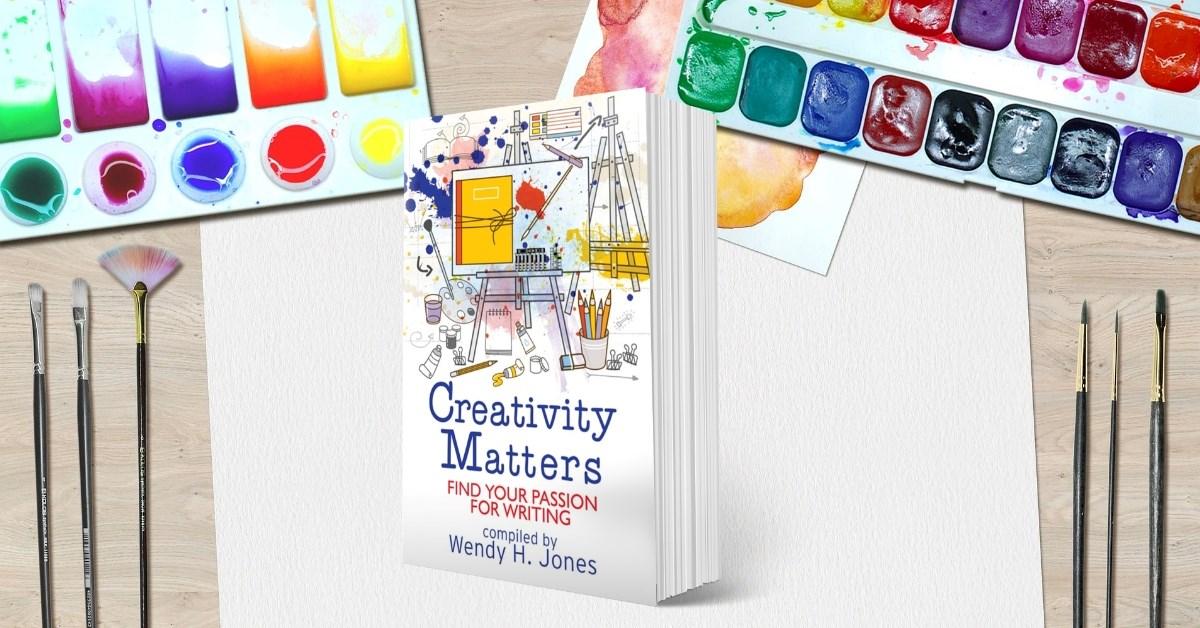

Brought
Marketing seems to be one of those areas that every author struggles with. It’s the same struggle companies world-wide have been dealing with for decades. How do I get my product in front of my target audience? Connections eMagazine can help. The publication is free to readers, bloggers and to authors looking for a little extra exposure. Visit our website for details.
https://melaniepsmith.com/


https://melaniepsmith.com/emagazine/
Connections eMagazine is a FREE quarterly publication founded by authors Melanie P. Smith and Rhoda D’Ettore. It is currently produced entirely by Editor, Melanie P. Smith. Over the years, the magazine has evolved and it now features promos, freebies, blog articles, and short stories in every issue.
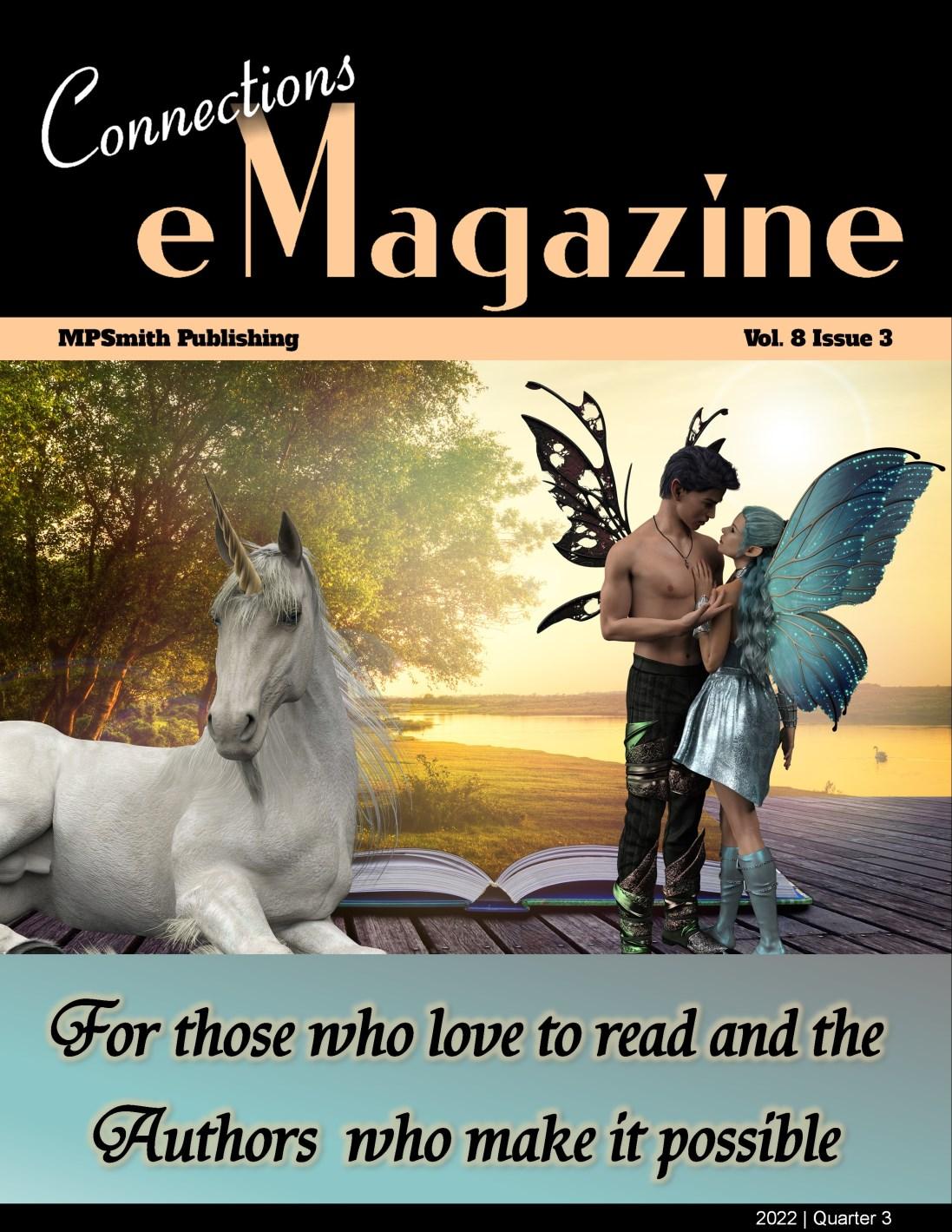

Discover more about Connections eMagazine on their website here:
https://melaniepsmith.com/emagazine-landing/
WendyH.Jones,EditorinChief, isalsoourFeatureEditorandworkshardtoprovidecontentthatisinteresting,informativeandprofessional. She’stheawardwinning,internationalbest-sellingauthoroftheDIShonaMcKenzieMysteries, CassClaymoreInvestigatesMysteries,FergusandFloraMysteries,BertietheBuffalochildren’sbooksandtheWriting Mattersbooksforwriters.SheisalsoawritingandmarketingcoachandformerPresidentoftheScottishAssociationof Writers. YoucanlearnmoreaboutWendyonherwebsite: https://www.wendyhjones.com/
OurDeputyEditoroverseesthephysicalcontentofthemagazineandcoordinatestheproductionschedule. Sheadministerstheday-to-dayoperationsofthepublication.Shealsoworkshardtocreatenewcoverseachmonththatcapturesthe essenceofeachpublication. SheenaMacleod Historicalfactandfictionwriter-lecturedattheUniversityofDundee, whereshegainedherPhD.SheistheauthorofReignoftheMarionettes,TearsofStrathnaverandWomenofCourage AForgottenFigure FrancesConnelly. https://www.sheenas-books.co.uk
TheExecutiveEditor/GraphicDesignerisresponsiblefordevelopingthelayoutanddesignofMFReMagazine. Eileenis responsibleforthegraphicsthatappearthroughoutthepublicationeachmonth. Sheworkshardtoensuretheimages capturethespiritandmessageourauthor'sconveyintheirarticles.Eileenwritesmainlycontemporarywomen’sfiction.Her worksincludethe ChrysalisTrilogyandIsleof Somewhere.
Ourmanagingeditormanagessubmissions,setsrealisticschedulesandorganizeseacheditionofthemagazine.andstories. Pauline is a prolific novelist and children’s author. Based in Scotland, she writes both suspenseful romance and children’s picture books for 3 to 7 years. With a background in Primary Literacy Support, Pauline is passionate in encouraging children in their own reading and writing.

Allison Symes works diligently each month to generate flash fiction writing prompts that will stimulate creativity in our authorsandentertainourreaders.AsStoryEditor,shealsoensureseachentryisprofessionalandpolished.Allison Symes is an award winning, published flash fiction and short story writer. She also writes a weekly column on topics of interest for writers for online magazine, Chandler's Ford Today. Allison's fiction has appeared in anthologies (CafeLit and Bridge House Publishing) over many years. Allison judges competitions, runs workshops, and is always happy to talk/write about flash fiction writing. https:// allisonsymescollectedworks.com
OurCopyEditorsforMom’sworkhardtoensurecontentisappropriateandfreeofgrammaticalandspellingerrors.
OurMarketingDirector,MaressaMortimer,overseesmarketingcampaignsandsocialmediaengagementforourmagazine. ShemanagesMom’sFacebook and Instagram pages. Maressa is the author of the Elabi Chronicles, Burrowed and Saphire Beach.
Our Content Writers are freelance authors who contribute articles, short stories, etc. to the eMagazine on a regular basis. They work hard to make our magazine interesting and professional.

Gettoknowsomeof ourContentWritershere:
ChantelBellehumeur- https://author-chantal-bellehumeur.webnode.com/products-/
JoyMargetts- www.joymargetts.com
LisaShambrook- www.amaranthalchemy.etsy.com.
PennyLuker - www.pennyluker.wordpress.com
Peter Thomas - www.pbthomas.com
Allie Marie - www.alliemariebooks.wordpress.com
Jenny Sanders - https://dancingthroughchaos.wordpress.com/
Anne Treur - https://DitisAnne.nl-/
Discover amazing authors… https://moms-favorite-reads.com/moms-authors/
